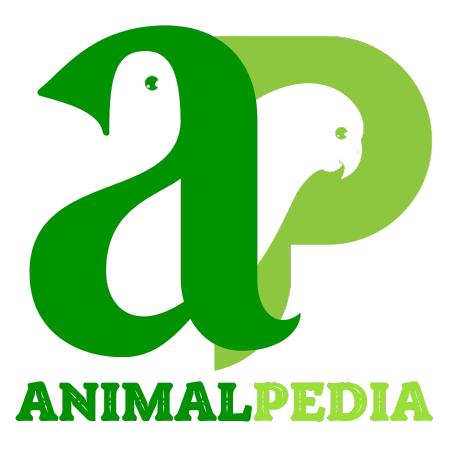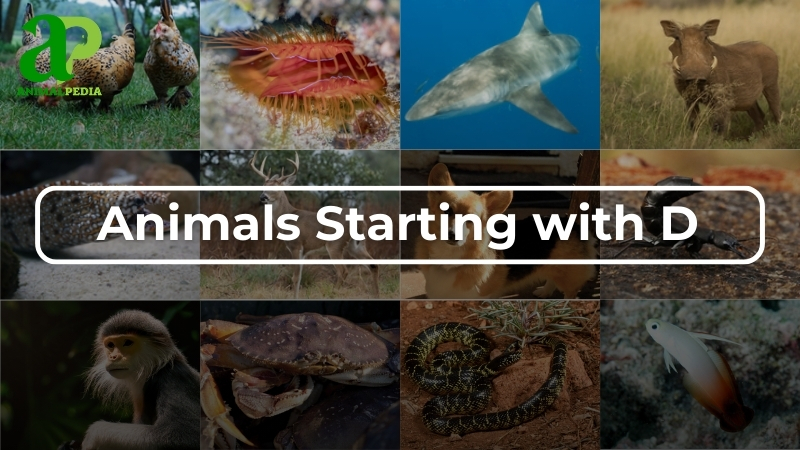Most popular animals that start with D
Animals that start with the letter ‘D’ provide a fascinating window into the diversity of life on Earth. From the majestic deer to the playful dolphin and the striking diamondback rattlesnake, each creature showcases unique adaptations and ecological roles. Whether soaring through the skies, roaming the land, or swimming beneath the waves, these animals inspire awe and deepen our appreciation for nature’s wonders. Perfect for wildlife enthusiasts, students, or the curious at heart, exploring animals that start with ‘D’ is a journey into the rich tapestry of the natural world.
| Dachshund | Dorgi | Donkey |
| Deer | Dunnart | Dragonfly |
| Danios | Dolphin | Duck |
| Dormouse | Dik-Dik | Dingo |
| Dugong | Dhole |
1. Dachshund
The Dachshund (Badger hound), a hound dog originating in Germany. Developed in the 15th century, this breed truly flourished during the 17th century. Then it was brought to America and became the popular species it is today. These miniature canines typically stand 8-9 inches tall and 21.5-25 inches long, with a weight range of 16-32 pounds.
Their muscular bodies are supported by large, paddle-shaped front paws. It has an elongated body and short legs. Dachshunds come in a variety of coat types – smooth, longhaired, or wirehaired – and various colors. Despite their miniature stature, dachshunds are renowned for their bravery, often confronting animals significantly larger than themselves. They demonstrate adaptability to diverse environments, thriving in urban apartments as well as rural homes.

| Attributes | Quick facts |
|---|---|
| Size | 8–9 inches (20–23 cm) for standard; 5–6 inches (13–15 cm) for miniature |
| Weight | 16–32 pounds (7–14 kg) for standard; under 11 pounds (5 kg) for miniature |
| Lifespan | 12–16 years |
| Habitat | Domestic (household pets) |
| Diet | Commercial dog food, supplemented with proteins and vegetables |
| Social Structure | Highly social, thrives in family environments but can be independent |
| Conservation | Not applicable |
Fun Fact: They were bred in Germany 300 years ago to hunt badgers, hence the name “badger hound”.
2. Dorgi
Dorgi (Dachshund Corgi Mix) is a mix between a Dachshund and a Corgi, predominantly found in European households. They are a long body, larger in length than height, inherit a Dachshund, with short legs, large erect ears, and a fox-like appearance akin to a Corgi. Their coat is short, either soft or wiry, and comes in a variety of colors including brown, fawn, red, and cream. They weigh between 15-28 pounds and stand 9 to 12 inches tall. They can get along well with other pets and small children if properly supervised.
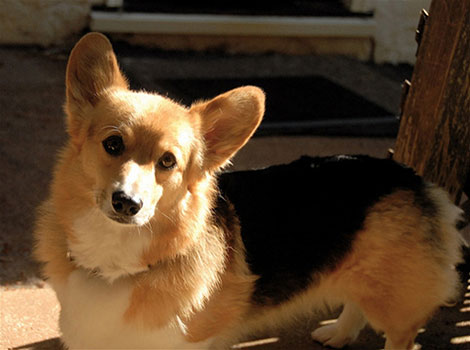
| Attributes | Quick facts |
|---|---|
| Size | 9–12 inches (23–30 cm) |
| Weight | 15–28 pounds (7–13 kg) |
| Lifespan | 12–15 years |
| Habitat | Domestic (household pets) |
| Diet | Commercial dog food, supplemented with proteins, vegetables, and grains |
| Social Structure | Highly social, thrives in family environments |
| Conservation | Not applicable |
Fun Fact: Queen Elizabeth II is credited with the creation of the first Dorgi when her Corgi mated with a Dachshund named Pipkin.
3. Donkey
Donkey (Ass) are found in various parts of the world, particularly in areas where agriculture and transportation are prevalent. Donkeys have gray or brown coats, with some breeds having unique colors or markings. An adult donkey’s weight ranges from 400–570 pounds (180–260 kg), and their length varies between 35–51 inches (90–130 cm). They exhibit a high level of independence in their thinking and decision-making, often prioritizing their safety.
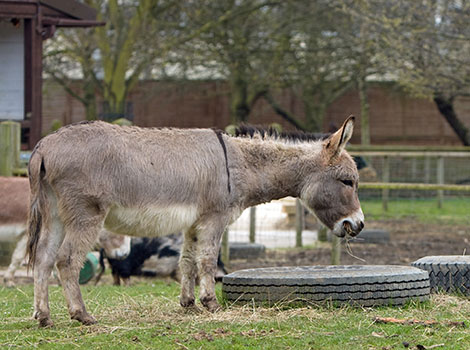
| Attributes | Quick facts |
|---|---|
| Size | 35–51 inches (90–130 cm) at the shoulder, depending on breed |
| Weight | 400–570 pounds (180–260 kg) |
| Lifespan | 25–30 years, longer in captivity |
| Habitat | Arid and semi-arid regions; domesticated donkeys are found globally |
| Diet | Herbivorous; grasses, shrubs, hay, and grains |
| Social Structure | Social animals; form herds or small groups in the wild |
| Conservation | Domesticated |
Fun Fact: Donkeys have an exceptional memory for recognizing areas and other donkeys they were with up to 25 years ago.
4. Deer
Deer (Venison) is found on every continent except Australia and Antarctica. The Deer’s body is sleek and streamlined, with long, powerful legs and a short tail. Their coats can vary in color from reddish-brown to grey, and some species even have spots. They communicate through a combination of sounds, body language, and scent marking. When they feel threatened, they may flatten their ears, stomp a foot, swish their tail high in the air, and run away.
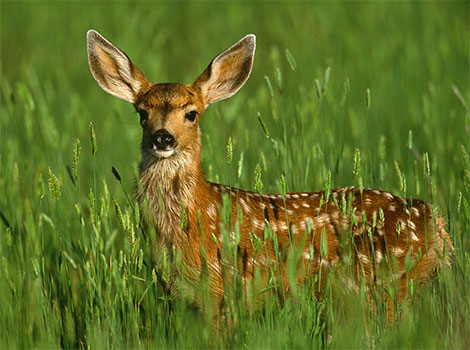
| Attributes | Quick facts |
|---|---|
| Size | 3–9 feet (90–270 cm) in length, depending on species |
| Weight | 30–700 pounds (14–320 kg), depending on species |
| Lifespan | 10–20 years in the wild |
| Habitat | Forests, grasslands, wetlands, and tundras worldwide, except Antarctica and Australia |
| Diet | Herbivorous; grasses, leaves, shoots, fruits, and bark |
| Social Structure | Varies by species; some are solitary, others form herds |
| Conservation | Varies by species, ranging from Least Concern |
Fun Fact: Deer have an exceptional sense of smell, which they enhance by keeping their noses moist through constant licking.
5. Dunnart
Dunnart (Sminthopsis), a marsupial native to Australia, is similar in size to a European mouse. It has a largely insectivorous diet. The Julia Creek Dunnart, one of the largest species, can reach up to 2–4 inches (5–10 cm) from snout to tail, and weighs up to 0.4–0.9 ounces (10–25 grams). They have big black eyes, long whiskers, large ears, and sharp teeth.
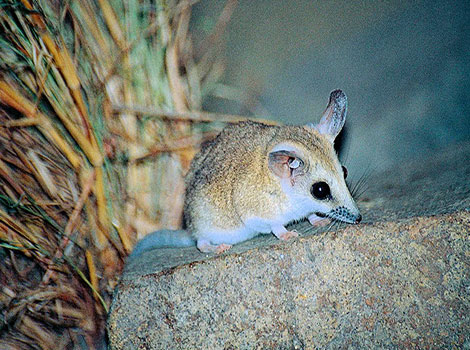
| Attributes | Quick facts |
|---|---|
| Size | 2–4 inches (5–10 cm) |
| Weight | 0.4–0.9 ounces (10–25 grams) |
| Lifespan | 1–2 years in the wild, up to 5 years in captivity |
| Habitat | Arid, semi-arid, and grassland regions of Australia |
| Diet | Insects, spiders, and small invertebrates |
| Social Structure | Solitary, except during mating |
| Conservation | Least Concern |
Fun Fact: Dunnarts have one of the shortest pregnancies of any mammal – only 13.5 days.
6. Dragonfly
Dragonflies (Anisoptera), insects renowned for their aerial prowess, are found near bodies of freshwater across most of the globe. These elegant creatures boast elongated bodies adorned with two sets of intricately veined, transparent wings. While primarily clear, the wings may also display vibrant markings. A dragonfly’s wingspan can reach an impressive 1–5 inches (2.5–12.5 cm) wingspan, and their weight typically ranges from 0.01–0.03 ounces (0.3–1 gram). Masterful aviators, dragonflies hunt and capture prey mid-flight, exhibiting a remarkable appetite as they consume a diverse array of smaller insects.
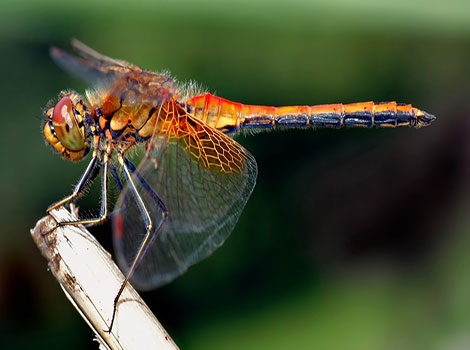
| Attributes | Quick facts |
|---|---|
| Size | 1–5 inches (2.5–12.5 cm) wingspan, depending on species |
| Weight | 0.01–0.03 ounces (0.3–1 gram) |
| Lifespan | Weeks to months as adults; 1–2 years as aquatic larvae (nymphs) |
| Habitat | Freshwater habitats like ponds, lakes, streams, and marshes worldwide |
| Diet | Carnivorous; flies, mosquitoes, midges, and other small insects |
| Social Structure | Solitary, though often found near water in large numbers |
| Conservation | Least Concern |
Fun Fact: They were among the first winged insects to evolve, taking flight over 300 million years ago.
7. Danios
Danios (Zebrafish), a group of small and active freshwater fish, are native to South and Southeast Asia, including India, Bangladesh, Myanmar, and Thailand. They inhabit a wide range of water bodies, from slow-flowing rivers to streams. The typical body size ranges from 1–2.5 inches (2.5–6.5 cm). Danios exhibit a wide variety of vibrant patterns, from the zebra-esque stripes seen in Zebrafish, to the leopard-like spots of Leopard Danios, and the luminous colors of the Glowlight Danio. They are sociable beings that flourish in collective settings. In the wild, they are known to swim together in large schools, and this behavior carries over to aquariums. They are known for their playful behavior and can often be seen darting back and forth across the tank.
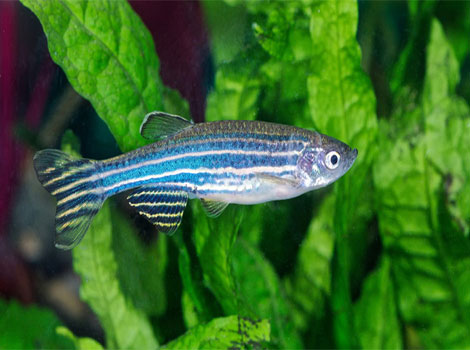
| Attributes | Quick facts |
|---|---|
| Size | 1–2.5 inches (2.5–6.5 cm), depending on species |
| Weight | Less than 1 ounce (< 28 grams) |
| Lifespan | 2–5 years |
| Habitat | Freshwater streams, rivers, and ponds in South and Southeast Asia |
| Diet | Omnivorous; insects, crustaceans, plant matter, and small invertebrates |
| Social Structure | Schooling fish, highly social |
| Conservation | Varies by species, most are Least Concern |
Fun Fact: Humans and this zebra danios share 70 percent of their genes.
8. Dolphin
Dolphin (Porpoise) is found in oceans worldwide, as well as in some rivers in South Asia and South America. They prefer shallow seas and continental shelves as their habitat. Their coloration varies from light to dark gray on their backs, which fades to white on their underbelly and beneath their jaws.
Dolphins range in size from 4–30 feet (1.2–9 meters) and weigh up to 90–11,000 pounds (40–5,000 kg). Dolphins use echolocation, a type of sonar, to navigate underwater. They are active day and night, with peak activity in the morning and afternoon. Dolphins hunt and forage in groups, with some members taking turns hunting or standing guard.
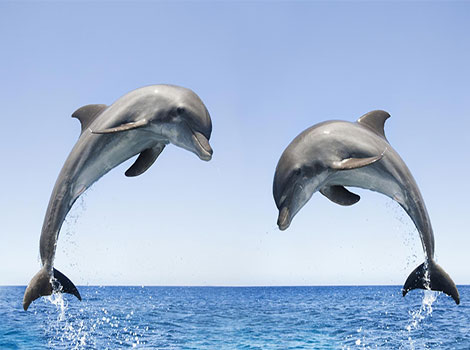
| Attributes | Quick facts |
|---|---|
| Size | 4–30 feet (1.2–9 meters), depending on species |
| Weight | 90–11,000 pounds (40–5,000 kg), depending on species |
| Lifespan | 20–60 years, depending on species |
| Habitat | Oceans, coastal regions, and some freshwater rivers worldwide |
| Diet | Carnivorous; fish, squid, and crustaceans |
| Social Structure | Highly social, living in pods of 5–20 individuals or larger groups |
| Conservation | Varies by species; some are Least Concern |
Fun Fact: Dolphins can recognize themselves in a mirror and seem to enjoy their reflections.
9. Duck
Duck (Waterfowl) is a member of the Anatidae family and is found in both fresh and seawater environments. These animals have a torpedo-shaped body, a rounded head, and a slightly flattened and rounded bill. Adult males weigh between 2.4 and 3.5 pounds (1.1 kg to 1.6 kg), and females weigh between 1.8 and 3.3 pounds (0.8 kg to 1.5 kg). Ducks are social birds that live in groups and have a strong family bond with their offspring. They share a home range or territory with other ducks for mating and feeding.
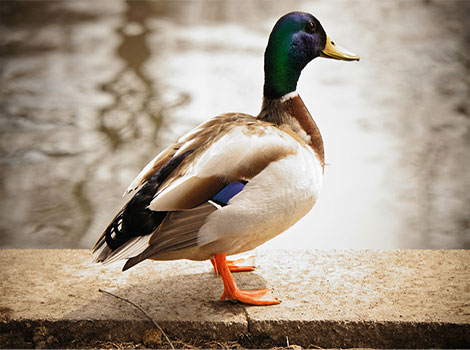
| Attributes | Quick facts |
|---|---|
| Size | 12–26 inches (30–65 cm) in length, depending on species |
| Weight | 1–3.3 pounds (0.5–1.5 kg) |
| Lifespan | 5–10 years in the wild; up to 20 years in captivity |
| Habitat | Wetlands, rivers, lakes, and coastal waters worldwide |
| Diet | Omnivorous; aquatic plants, insects, small fish, and seeds |
| Social Structure | Social, often forming flocks, especially during migration |
| Conservation | Varies by species; many are Least Concern |
Fun Fact: A Mallard duck was once struck by a jet plane over Nevada at an altitude of 21,000 feet.
10. Dormouse
Dormouse (Hazel Dormouse) is a small rodent that belongs to the Gliridae family. Its habitat extends throughout Europe, Africa, and Asia, favoring deciduous and mixed woodlands with a rich understory. These arboreal animals have soft fur, large black eyes, and bushy tails. The color of its fur can vary from golden brown to gray. A Dormouse grows up to 2–8 inches (5–20 cm) in body length and weighs between 0.6–7 ounces (15–200 grams). They are nocturnal and spend most of their time in trees, rarely coming to the ground. They have long hibernation periods, which can last up to six months or more.
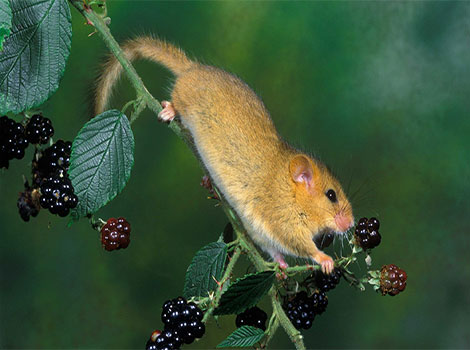
| Attributes | Quick facts |
|---|---|
| Size | 2–8 inches (5–20 cm), with a tail of similar length, depending on species |
| Weight | 0.6–7 ounces (15–200 grams) |
| Lifespan | 3–5 years in the wild; up to 10 years in captivity |
| Habitat | Woodlands, hedgerows, and shrublands in Europe, Africa, and Asia |
| Diet | Omnivorous; nuts, seeds, fruits, insects, and flowers |
| Social Structure | Solitary or small family groups, particularly during hibernation |
| Conservation | Least Concern |
Fun Fact: Dormice can remember the exact location of their food sources even after a long hibernation period.
11. Dik-Dik
Dik-Dik (Antelope) is a small antelope species in the Bovidae family. Originating from Eastern and Southern Africa, they have adapted to various habitats including savannas, shrublands, and dry, thicketed areas. These animals have a soft, tan, or grayish-brown coat, large dark eyes encircled by a white ring, and an elongated snout. Male Dik-Diks are equipped with small, sharp horns concealed by a tuft of hair on their forehead, while females are hornless. They have a height of 12 to 16 inches at the shoulder and weigh between 6–13 pounds (3–6 kg). They are shy and elusive in nature, often hiding in bushy vegetation to avoid detection.
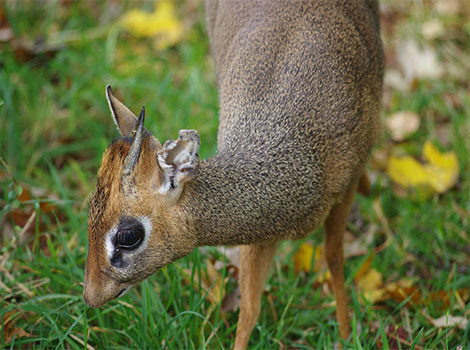
| Attributes | Quick facts |
|---|---|
| Size | 20–28 inches (50–70 cm) in length, 12–16 inches (30–40 cm) in height at the shoulder |
| Weight | 6–13 pounds (3–6 kg) |
| Lifespan | 10–12 years in the wild; up to 18 years in captivity |
| Habitat | Shrublands, savannas, and dry forests in Eastern and Southern Africa |
| Diet | Herbivorous; leaves, shoots, fruits, and grasses |
| Social Structure | Monogamous pairs, often territorial |
| Conservation | Least Concern |
Fun Fact: When frightened, Dik-Diks run in a zig-zag pattern at speeds up to 26mph.
12. Dingo
Dingo (Warrigal) is native to Australia. They have short soft fur, a bushy tail, and erect pointed ears. Their coat color ranges from yellowish to reddish brown, often with white underparts, paws, and tail tips. Standing about 60 cm tall at the shoulder and weighing between 29–44 pounds (13–20 kg). Dingoes are sociable animals that often live in packs of up to ten. They pursue small games such as rabbits, rodents, birds, and lizards.
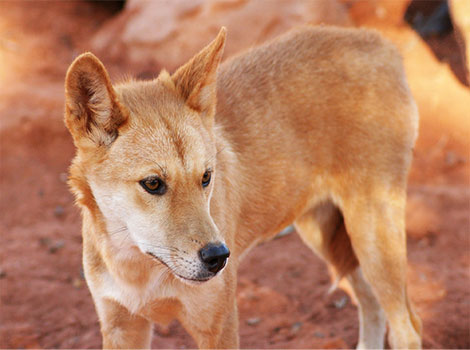
| Attributes | Quick facts |
|---|---|
| Size | 3.5–4 feet (90–120 cm) in length, 1.7–2 feet (50–60 cm) at the shoulder |
| Weight | 29–44 pounds (13–20 kg) |
| Lifespan | 10–13 years in the wild; up to 20 years in captivity |
| Habitat | Deserts, grasslands, forests, and coastal regions in Australia and Southeast Asia |
| Diet | Carnivorous; mammals, birds, reptiles, and occasionally fruits and plants |
| Social Structure | Lives in packs of up to 10 individuals, though some are solitary |
| Conservation | Vulnerable |
Fun Fact: Dingoes can swivel their heads about 180 degrees.
13. Dugong
Dugong (Sea Cow) thrives in the warm coastal waters of the Indian and Pacific oceans. These animals have a large, grey-brown body that tapers at the ends and a flattened fluked tail similar to a whale’s. They measure between 8 to 10 feet in length and weigh between 550–900 pounds. Dugongs are often found alone or in pairs, but they can sometimes be seen in large herds. They feed on underwater grasses day and night, using their bristled, sensitive snouts to root for food and their rough lips to eat.
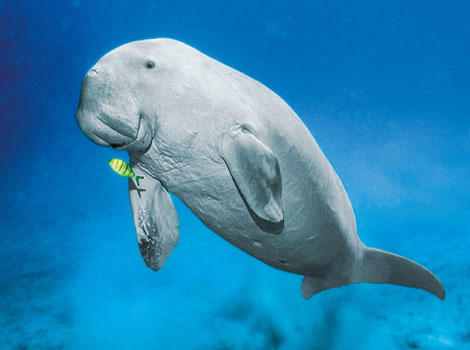
| Attributes | Quick facts |
|---|---|
| Size | 8–10 feet (2.4–3 meters) |
| Weight | 550–900 pounds (250–400 kg) |
| Lifespan | 50–70 years |
| Habitat | Coastal and shallow waters, particularly seagrass beds, in the Indo-Pacific region |
| Diet | Herbivorous; primarily seagrass |
| Social Structure | Solitary or small groups, though larger gatherings may occur in rich feeding areas |
| Conservation | Vulnerable |
Fun Fact: Dugongs are more closely related to elephants than other marine mammals.
14. Dhole
Dhole (Asiatic Wild Dog) is also known as the Asiatic wild dog, Red dog, or Indian wild dog, is a unique canid species within the Canidae family. Its habitat spans across Central, South, East, and Southeast Asia, where it thrives in diverse environments such as dense forests, mountainous alpine steppes, and thick jungles. They have a lean and muscular body, a reddish-brown coat that varies in shade depending on their geographical location, rounded ears, a bushy tail, and a dark muzzle.
The adult Dhole measures approximately 30–43 inches (75–110 cm) in length, stands 17 to 22 inches tall at the shoulder, and weighs between 26–44 pounds (12–20 kg). These highly social animals live in large, cooperative clans without strict dominance hierarchies. They are known for their exceptional stamina, covering vast distances in pursuit of prey like deer and wild boar.
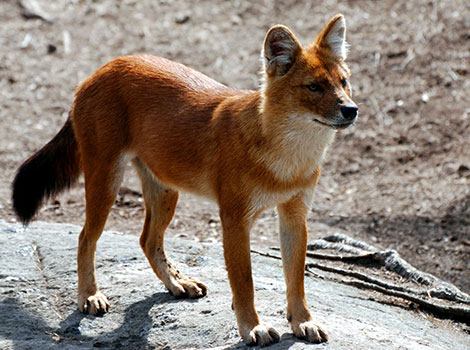
| Attributes | Quick facts |
|---|---|
| Size | 30–43 inches (75–110 cm) in body length, with a tail of 14–18 inches (35–45 cm) |
| Weight | 26–44 pounds (12–20 kg) |
| Lifespan | 10–13 years in the wild |
| Habitat | Forests, grasslands, and mountainous regions in South and Southeast Asia |
| Diet | Carnivorous; deer, wild boar, small mammals, and occasionally birds |
| Social Structure | Lives in packs of 5–12 individuals with complex social hierarchies |
| Conservation | Endangered |
Fun Fact: Dholes can whistle, make high-pitched screams, and even “cluck” like a chicken.
Moving from the broad variety of popular animals, let’s narrow our focus to mammals. These warm-blooded creatures starting with ‘D’ showcase impressive adaptability and biological diversity.
Mammals that start with D
Mammals beginning with ‘D’ exemplify the adaptability of this group, including species like deer, dolphins, and dholes, all thriving in diverse habitats worldwide.
| Dromedary Camel | Deer Mouse | Duiker |
| De Brazza’s Monkey | Dama Wallaby | Dassie Rat |
| Damara Zebra | Diminutive Woodrat | Desert Warthog |
| Dybowski’s Sika Deer | Dark Flying Fox | Desert Wolf |
| Darwin’s Fox | Dama Gazelle | Douc |
15. Dromedary Camel
Dromedary Camel (Arabian Camel) is a member of the Camelidae family. It is typically found in the Middle East, northern India, and Africa. These animals have fur ranging from cream to brown. It has long, slender legs, broad, flat feet for walking on sand, and long eyelashes and ear hairs for protection against sand. Adult camels stand between 7–11 feet (2.1–3.4 meters) at the shoulder and weigh between 880–1,320 pounds (400–600 kg). They are endurance and ability to travel long distances over harsh desert terrain. Dromedaries are social animals and are often found in groups.
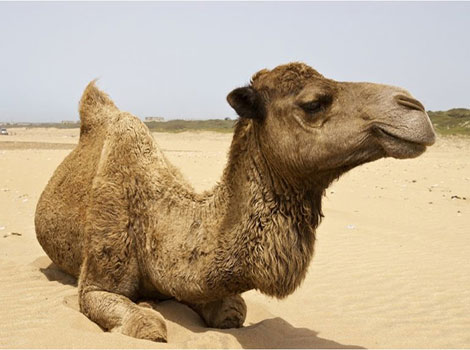
| Attributes | Quick facts |
|---|---|
| Size | 7–11 feet (2.1–3.4 meters) in length; 6–7 feet (1.8–2.1 meters) at the shoulder |
| Weight | 880–1,320 pounds (400–600 kg) |
| Lifespan | 40–50 years |
| Habitat | Deserts and arid regions of the Middle East, North Africa, and South Asia |
| Diet | Herbivorous; thorny plants, dry grasses, and desert vegetation |
| Social Structure | Lives in herds or semi-domesticated groups led by a dominant male |
| Conservation | Domesticated |
Fun Fact: Dromedary camels have been domesticated for over 5,000 years and have been used for transportation.
16. Deer Mouse
Deer Mouse (Field Mouse) is indigenous to North America, with its habitat stretching from Alaska and northern Canada to western Panama. These animals have large eyes and ears, a bicolored tail, and fur that ranges in color from gray to brown, with a distinctive white underside and white feet.
It measures between 2.8–3.9 inches (7–10 cm) in length and weighs from 0.4–1.0 ounces (12–28 grams), these rodents adapt to diverse habitats, including forests, grasslands, and even deserts. The Deer Mouse is a nocturnal species that spends the day in burrows or trees, building nests from plant material. It is an agile climber and has a diverse diet that includes plant products, fungi, invertebrates, and carrion.
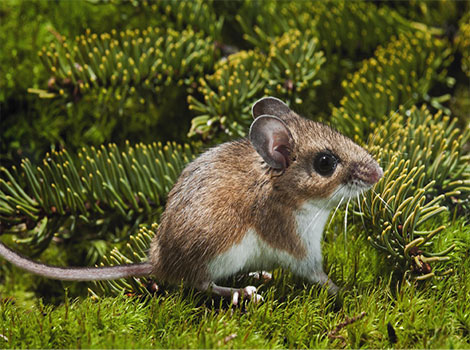
| Attributes | Quick facts |
|---|---|
| Size | 2.8–3.9 inches (7–10 cm) body length, with a 2–5 inch (5–13 cm) tail |
| Weight | 0.4–1.0 ounces (12–28 grams) |
| Lifespan | 2–4 years in the wild |
| Habitat | Forests, grasslands, deserts, and agricultural areas across North America |
| Diet | Omnivorous; seeds, fruits, insects, and fungi |
| Social Structure | Solitary or small family groups; territorial in nature |
| Conservation | Least Concern |
Fun Fact: Despite their small size, Deer Mice are quite agile and are excellent swimmers.
17. Duiker
Duiker (Diving Buck) is a small antelope. Its habitat spans across sub-Saharan Africa. These animals have a low-slung body, slender legs, wedge-shaped head topped by a crest of long hair, and relatively large eyes. Duiker stand between 20–35 inches (50–90 cm) tall and weigh anywhere from 20–55 pounds (9–25 kg). They are most active during the early morning, evening, and night, and both males and females are territorial. Duiker’s has a diverse diet that includes leaves, fruit, seeds, carrion, and insects.
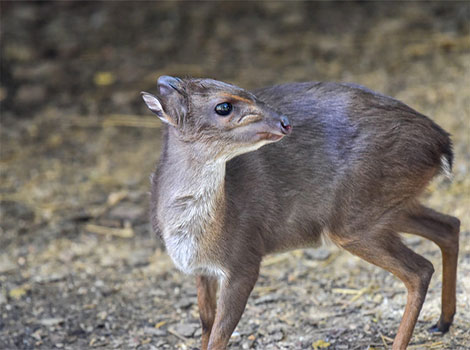
| Attributes | Quick facts |
|---|---|
| Size | 20–35 inches (50–90 cm) in length, depending on species |
| Weight | 20–55 pounds (9–25 kg), depending on species |
| Lifespan | 8–12 years in the wild; up to 15 years in captivity |
| Habitat | Forests, savannas, and dense bushlands in Sub-Saharan Africa |
| Diet | Omnivorous; leaves, fruits, seeds, and occasionally small animals or insects |
| Social Structure | Solitary or small pairs; highly territorial |
| Conservation | Least Concern |
Fun Fact: They can survive without drinking water
18. De Brazza’s Monkey
De Brazza’s Monkey (Swamp Monkey) is a primate species that belongs to the Cercopithecidae family. It is native to the swamp and riverine forests of Central Africa. This monkey is grey agouti fur with a reddish-brown back, black limbs and tail, and a white rump.
The males of this species weigh around 9–18 pounds (4–8 kg), while the females weigh around 4 kilograms. De Brazza’s Monkeys are both terrestrial and arboreal, and they are social animals that form small groups of 4-10 individuals. They are highly territorial and do not tend to associate with other monkey species.
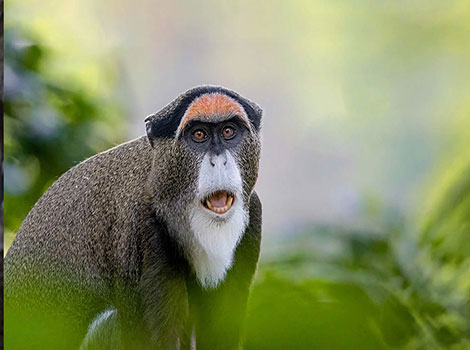
| Attributes | Quick facts |
|---|---|
| Size | 16–25 inches (40–64 cm) in body length; tail adds 20–30 inches (51–76 cm) |
| Weight | 9–18 pounds (4–8 kg), with males larger than females |
| Lifespan | 22–30 years in captivity; slightly shorter in the wild |
| Habitat | Wetlands, forests, and swamps in Central Africa |
| Diet | Omnivorous; fruits, seeds, leaves, insects, and small animals |
| Social Structure | Lives in small family groups, typically led by a dominant male |
| Conservation | Least Concern |
Fun Fact: De Brazza’s Monkeys can remain motionless for up to 8 hours when they feel threatened.
19. Dama Wallaby
Dama Wallaby (Tammar Wallaby) is a member of the Macropodidae family, originating from the southern and southwestern coastal regions of Australia. This species is grayish-brown fur, lighter on the throat, chest, and stomach, and its small head, large ears, and tapered tail.
The body and head lengths are 23–30 inches (58–76 cm), with a tail measuring between 15 to 17 inches, males weigh up to 30–50 pounds (14–23 kg), while females weigh up to 15 pounds. These creatures are solitary but can occasionally be found in pairs or small groups.
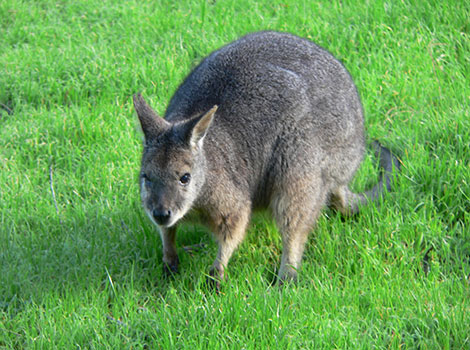
| Attributes | Quick facts |
|---|---|
| Size | 23–30 inches (58–76 cm) in body length; tail adds 20–28 inches (50–70 cm) |
| Weight | 30–50 pounds (14–23 kg) |
| Lifespan | 12–15 years in the wild; up to 20 years in captivity |
| Habitat | Woodlands, grasslands, and scrublands in Australia and Tasmania |
| Diet | Herbivorous; grasses, leaves, and shrubs |
| Social Structure | Solitary or small groups, often gathering in feeding areas |
| Conservation | Least Concern |
Fun Fact: When Dama Wallabies sense danger, they emit a warning thump with their hind legs.
20. Dassie Rat
Dassie Rat (Rock Rat) is a member of the Petromuridae family. Its habitat is the arid, rocky regions of southwestern Africa. They have a broad, flat head and flexible ribs and fur is soft, silky, and its color varies from pale gray to dark chocolate brown. These animal weight between 5–8 ounces (150–250 grams) and measuring 6–8 inches (15–20 cm) in length. It is diurnal and often be seen moving alone or in pairs. They diet is primarily plant-based, consisting of grasses, flowers, leaves, and fruit.
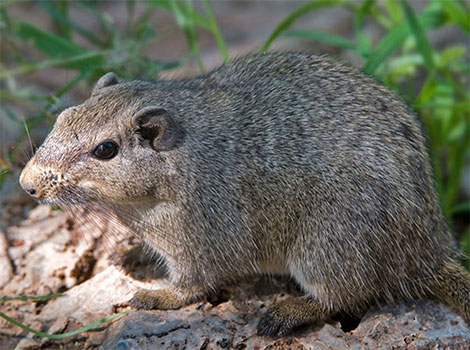
| Attributes | Quick facts |
|---|---|
| Size | 6–8 inches (15–20 cm) in body length; tail adds 4–6 inches (10–15 cm) |
| Weight | 5–8 ounces (150–250 grams) |
| Lifespan | 3–4 years in the wild |
| Habitat | Rocky outcrops and arid regions in Southern Africa |
| Diet | Herbivorous; leaves, flowers, and grasses |
| Social Structure | Lives in small family groups, often sheltering in rock crevices |
| Conservation | Least Concern |
Fun Fact: The Dassie Rat is the only rodent known to regurgitate food for re-chewing.
21. Damara Zebra
Damara Zebra (Burchell Zebra) is native to southeast Africa and inhabits grasslands, savannahs, and sometimes wooded areas. They are medium-sized, thick-bodied animals with relatively short legs. Both males and females stand about 45–55 inches (115–140 cm) high at the shoulder with newborns weighing a hefty 550–770 pounds (250–350 kg).
Their bodies are striped on the head, neck, flanks, and sparsely down the upper segments of the limbs, then fading to white. They live in small family groups, often congregating in larger herds around water and food sources.

| Attributes | Quick facts |
|---|---|
| Size | 45–55 inches (115–140 cm) at the shoulder; body length 6.9–8.5 feet (210–260 cm) |
| Weight | 550–770 pounds (250–350 kg) |
| Lifespan | 20–25 years in the wild |
| Habitat | Arid and semi-arid regions, including savannas and grasslands in Namibia and Angola |
| Diet | Herbivorous; grasses, shrubs, and leaves |
| Social Structure | Lives in herds, consisting of a dominant stallion, several mares, and their offspring |
| Conservation | Least Concern |
Fun Fact: Every zebra can be identified by its own unique set of stripes.
22. Diminutive Woodrat
The Diminutive Woodrat (Neotoma lepida), a tiny rodent endemic to Mexico, primarily inhabits the cool, moist, upper reaches of mountain forests. These elusive creatures typically dwell in coniferous forests at elevations between 4,900 and 9,800 feet (1,500 and 3,000 meters).
Their ash-gray to light brown fur provides excellent camouflage amongst the trees and rocks of their habitat. While primarily terrestrial, the Diminutive Woodrat exhibits some arboreal tendencies, as evidenced by the discovery of Nelsonia tails (prehensile tails used for grasping) in trees. They possess long, well-furred tails for balance and maneuvering through their complex environment.

| Attributes | Quick facts |
|---|---|
| Size | 6–8 inches (15–20 cm) in body length; tail adds 4–6 inches (10–15 cm) |
| Weight | 0.7–1.2 ounces (20–35 grams) |
| Lifespan | 2–3 years in the wild |
| Habitat | Rocky outcrops, woodlands, and arid regions in North America |
| Diet | Herbivorous; seeds, leaves, fruits, and bark |
| Social Structure | Solitary, with territorial behavior around nesting areas |
| Conservation | Least Concern |
Fun Fact: Despite being elusive, the presence of a Nelsonia tail in a tree indicates these woodrats may be arboreal at times.
23. Desert Warthog
Desert Warthog (Phacochoerus aethiopicus) is found in open arid countryside including thin woodland with scattered trees, xerophytic scrubland, and sandy plains. It has a body length of 3.6–5 feet (110–150 cm) and weighs between 100–200 pounds (45–91 kg). The Desert Warthog is a stockily-built animal with a rather flattened head, distinctive facial paired protuberances, and large curving canine teeth that protrude as tusks.
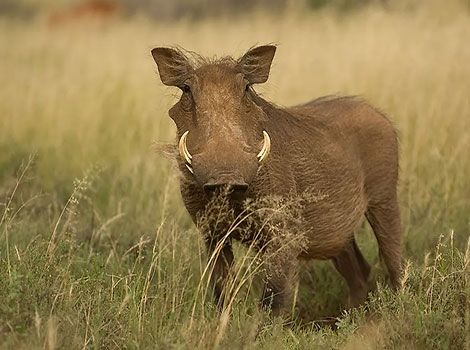
| Attributes | Quick facts |
|---|---|
| Size | 3.6–5 feet (110–150 cm) in body length; shoulder height 26–33 inches (65–85 cm) |
| Weight | 100–200 pounds (45–91 kg) |
| Lifespan | 12–15 years in the wild |
| Habitat | Arid and semi-arid regions, including savannas and scrublands in the Horn of Africa (Ethiopia, Somalia, Kenya) |
| Diet | Omnivorous; grasses, roots, fruits, and occasionally small animals or carrion |
| Social Structure | Lives in small family groups, typically led by a dominant female |
| Conservation | Least Concern |
Fun Fact: The Desert Warthog is usually nocturnal and active at night.
24. Dybowski’s Sika Deer
Dybowski’s Sika Deer (Japanese Deer), is originally native to the remote areas of Primorsky Krai in Russia. The deer’s fur is light-brown, and darkening. They have a body length of about 43–51 inches (110–130 cm), a tail up to 20 cm (7.9 in) long, and a height ranging from 75 to 110 cm (30 to 43 in), it is the largest among the 14 subspecies of sika deer. They mark their territories using shallow pits full of urination.
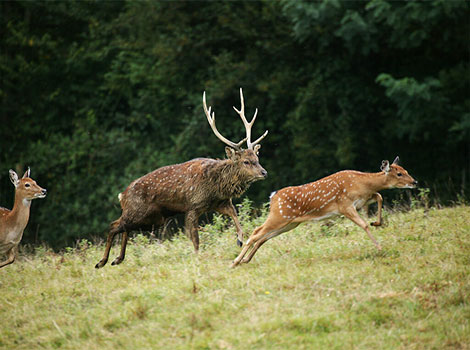
| Attributes | Quick facts |
|---|---|
| Size | 43–51 inches (110–130 cm) in body length; shoulder height 31–39 inches (80–100 cm) |
| Weight | 130–240 pounds (60–110 kg) |
| Lifespan | 10–15 years in the wild; up to 20 years in captivity |
| Habitat | Forests, grasslands, and marshy areas in East Asia, particularly northeastern China and Russia |
| Diet | Herbivorous; grasses, leaves, shoots, and acorns |
| Social Structure | Lives in small groups, with males often solitary outside the breeding season |
| Conservation | Near Threatened |
Fun Fact: This deer species is named after the Polish naturalist Benedykt Dybowski.
25. Dark Flying Fox
Dark Flying Fox (Pteropus vampyrus) is among the largest bats in the world, found only in Australia, Papua New Guinea, and Indonesia. It has a wingspan of more than a meter and weighs between 1.5–2.5 pounds (0.7–1.1 kg). The creature’s form is predominantly black, with the exception of a ring of rust-colored fur encircling its neck and hairs tipped with white on its belly. They rest by day in large roosts called camps and fly out at dusk to feed.
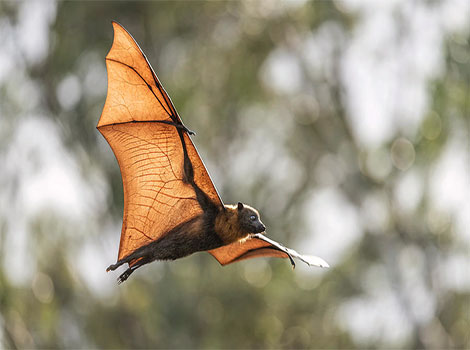
| Attributes | Quick facts |
|---|---|
| Size | Wingspan 3–4 feet (90–120 cm); body length 9–11 inches (23–28 cm) |
| Weight | 1.5–2.5 pounds (0.7–1.1 kg) |
| Lifespan | 12–15 years in the wild; up to 20 years in captivity |
| Habitat | Tropical forests, mangroves, and coastal areas in Southeast Asia and Australia |
| Diet | Frugivorous; fruits, nectar, and flowers |
| Social Structure | Highly social; roosts in large colonies |
| Conservation | Near Threatened |
Fun Fact: They use their keen sense of smell and sight, rather than echolocation like other bats, to navigate and find food in the night.
26. Desert Wolf
Desert Wolf (Arabian Wolf) is in Arabian Peninsula, including areas like Oman, southern Saudi Arabia, and Yemen. The wolf’s fur is brownish-gray, with a black mantle running down its back. Its eyes can be either deep yellow or brown. The Desert Wolf is 25–32 inches (63–81 cm) tall at the shoulder and weighs around 55 pounds. This species adapted to desert life, they often live in small groups and rely on their hunting skills to catch desert prey.
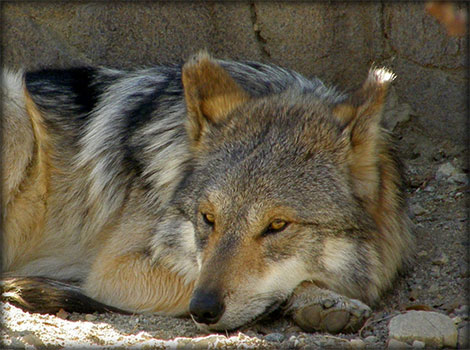
| Attributes | Quick facts |
|---|---|
| Size | 25–32 inches (63–81 cm) at the shoulder |
| Weight | 40–55 pounds (18–25 kg) |
| Lifespan | 5–7 years in the wild; up to 12 years in captivity |
| Habitat | Arid deserts, semi-deserts, and mountainous regions of the Arabian Peninsula and surrounding areas |
| Diet | Carnivorous; small to medium-sized mammals, birds, reptiles, and carrion |
| Social Structure | Lives in small packs or as solitary individuals |
| Conservation | Vulnerable |
Fun Fact: Desert Wolves are not known to howl like their larger relatives.
27. Darwin’s fox
Darwin’s fox (Zorro Chilote) is primarily in Chile. These foxes are named after Charles Darwin, who first collected a specimen in 1834 and is primarily found within Chile’s unique temperate rainforests. They have dark gray fur, tinged with red on the head and muzzle.
The size of Darwin’s fox ranges from 48 to 59 cm (19 to 23 in) in length, with a tail measuring between 20–22 inches (50–55 cm), weighing between 4.4–7.7 pounds (2–3.5 kg). These animals are nocturnal creatures, with peak activity occurring at twilight and before sunrise. They are usually solitary, but may be seen in pairs during mating season or when females are rearing their young.
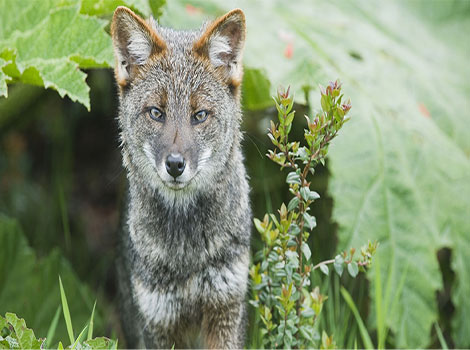
| Attributes | Quick facts |
|---|---|
| Size | 20–22 inches (50–55 cm) in body length; tail adds 7–10 inches (18–25 cm) |
| Weight | 4.4–7.7 pounds (2–3.5 kg) |
| Lifespan | 7–10 years in the wild |
| Habitat | Temperate rainforests and coastal forests in Chile, particularly on Chiloé Island and mainland areas like Nahuelbuta National Park |
| Diet | Omnivorous; small mammals, birds, insects, fruits, and berries |
| Social Structure | Solitary or small family groups |
| Conservation | Critically Endangered |
Fun Fact: It was a subspecies of the South American gray fox, but it was later classified as a separate species
28. Dama Gazelle
Dama Gazelle (Addra Gazelle) is native to the Sahara desert and the Sahel in Africa. The gazelle has a white body and a reddish-brown head and neck. This species stands about 53–65 inches (135–165 cm) tall at the shoulder and weighs between 88–165 pounds (40–75 kg). The Dama Gazelle is a diurnal and highly social creature, often found in mixed groups of 10 – 20 individuals, led by a single dominant male.
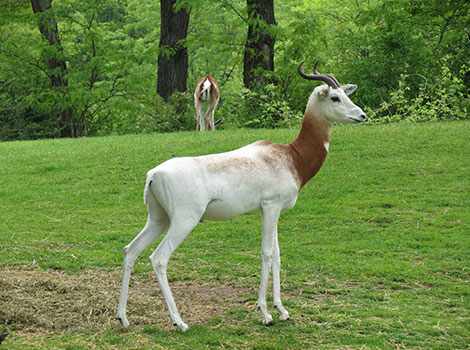
| Attributes | Quick facts |
|---|---|
| Size | 53–65 inches (135–165 cm) in length; 34–41 inches (86–105 cm) at the shoulder |
| Weight | 88–165 pounds (40–75 kg) |
| Lifespan | 12–15 years in the wild; up to 18 years in captivity |
| Habitat | Arid and semi-arid regions, including deserts and savannas in the Sahel region of Africa |
| Diet | Herbivorous; grasses, shrubs, and desert vegetation |
| Social Structure | Lives in small groups, sometimes forming larger herds during migration |
| Conservation | Critically Endangered |
Fun Fact: Dama Gazelles are the tallest species of their genus.
29. Douc
Douc (Douc Langur) is a member of the Cercopithecidae family, native to the tropical and monsoon forests of Southeast Asia, particularly central and southern Vietnam, southern Laos, and northeastern Cambodia. They have a blue-gray body resulting from black-and-white bands on each hair, a white face with black patches around the eyes, and red hands and feet.
These animals have a body length exceeding 21–30 inches (53–76 cm) , males weigh 15–25 pounds (7–12 kg), while females around 8.5 kg. Doucs live in small family groups led by a single adult male, with several adult females and many children.
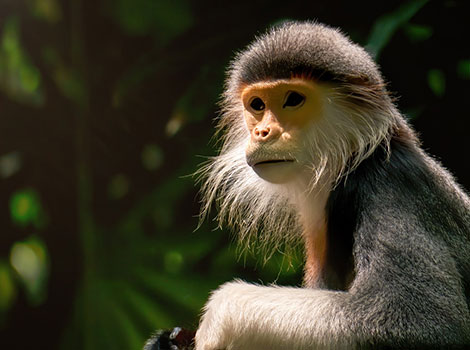
| Attributes | Quick facts |
|---|---|
| Size | 21–30 inches (53–76 cm) in body length, with tails as long as their bodies |
| Weight | 15–25 pounds (7–12 kg), depending on species and sex |
| Lifespan | 20–25 years in the wild |
| Habitat | Tropical and subtropical forests in Southeast Asia, including Vietnam, Laos, and Cambodia |
| Diet | Herbivorous; leaves, fruits, flowers, and seeds |
| Social Structure | Lives in groups of 4–15 individuals with complex social hierarchies |
| Conservation | Critically Endangered |
Fun Fact: They are adept climbers and spend most of their time in trees.
Having delved into the captivating mammals that start with ‘D,’ we now transition to reptiles. These fascinating creatures reveal their own remarkable survival tactics and physical traits.
Reptiles that start with D
Reptiles starting with ‘D’ include unique species like the desert iguana and diamondback rattlesnake, showcasing the adaptability and resilience of cold-blooded animals in various ecosystems.
| Dragon Snake | Death Adder | Desert Iguana |
| Dumeril’s Boa | Desert Ghost Ball Python | Desert Kingsnake |
| Dwarf Boa | Draco Volans Lizard | Diamond Python |
| Desert Tortoise | Dwarf Crocodile |
30. Dragon Snake
Dragon Snake (Xenodermus javanicus) is a small non-venomous, semi-fossorial snake species. It has a distinct head, long tail, and a slender and compressed body. The total length is about 50 cm. Unfortunately, specific height, width, and weight measurements are not readily available. This species is found in the Malay Peninsula and parts of the Greater Sunda Islands, inhabiting damp areas near water, including forests, swamps, marshes, and rice fields, at elevations below 1,300 m, but most commonly between 500–1,100 m above sea level. It is nocturnal and subsists on a frogs, tadpoles, and small fish diet.
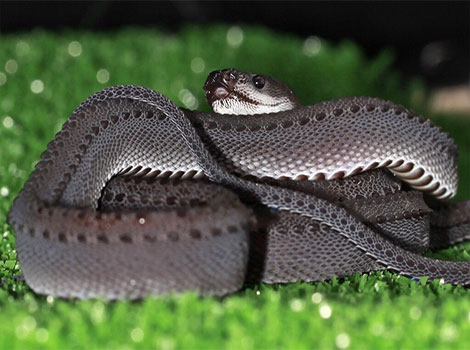
| Attributes | Quick facts |
|---|---|
| Size | Approximately 20 inches (50 cm) |
| Weight | Not readily available |
| Lifespan | 8–12 years (estimated) |
| Habitat | Damp forests, swamps, marshes, and rice fields in the Malay Peninsula and Greater Sunda Islands |
| Diet | Frogs, tadpoles, and small fish |
| Social Structure | Solitary |
| Conservation | Data Deficient |
Fun Fact: The Dragon Snake stiffens its entire body as a defense mechanism when threatened.
31. Death Adder
The Death Adder (Acanthophis) is a member of the Elapidae family, which is predominantly found in Australia. The snake has a broad, flattened, triangular head and a thick body, with bands of red, brown, and black on its back and a grey, cream, or pink belly. It can grow up to 1.3–3.3 feet (40–100 cm). They camouflage themselves with leaves and lie coiled in ambush, twitching their grub-like tail close to their heads as a lure to attract their prey.

| Attributes | Quick facts |
|---|---|
| Size | 1.3–3.3 feet (40–100 cm) |
| Weight | 2–3 pounds (0.9–1.4 kg) |
| Lifespan | 10–15 years |
| Habitat | Forests, woodlands, grasslands, and coastal regions in Australia and Papua New Guinea |
| Diet | Small mammals, birds, lizards, and frogs |
| Social Structure | Solitary |
| Conservation | Least Concern |
Fun Fact: Their diet is not limited to other snakes; it also includes small mammals, birds, lizards, and other reptiles.
32. Desert Iguana
Desert Iguana (Dipsosaurus dorsalis) is a species that thrives in the desert areas of northern Mexico and the southern United States. Its long cylindrical tail has white to gray encircled rows of dark spots. The mature desert iguana measures 10 to 16 inches long, weighing around 0.125–0.188 lb (0.06–0.09 kg). They mark their territory with fluorescent chemicals from their femoral pores. They are most active during hot midday hours.
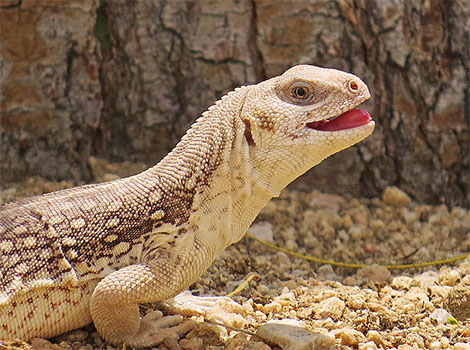
| Attributes | Quick facts |
|---|---|
| Size | 10–16 inches (25–40 cm) |
| Weight | 0.125–0.188 lb (0.06–0.09 kg) |
| Lifespan | 7–10 years |
| Habitat | Desert areas in northern Mexico and the southern United States |
| Diet | Leaves, flowers, and fruits; occasionally insects |
| Social Structure | Solitary; territorial |
| Conservation | Least Concern |
Fun Fact: They are polygynous, meaning that one male mates with more than one female.
33. Dumeril’s Boa
Dumeril’s Boa (Acrantophis dumerili) is a non-venomous boa species found in the southern, more arid regions of Madagascar. This snake lives mostly on the ground and can be found in dry forests, grasslands, agricultural areas, and villages. It has a gray-brown ground color with darker patches, which form an effective camouflage against the leaf litter of the forest floor of their native habitat. The average size of a Dumeril’s Boa ranges from 4–6 feet (120–180 cm) when fully grown. Females are larger and heavier than males. The average weight of a Dumeril’s Boa is around 10–20 pounds (4.5–9 kg). They are mainly terrestrial creatures that live and hunt on the ground. Adults are active both during the day and night. They prefer to spend time on their own and interact with each other only during the mating season.
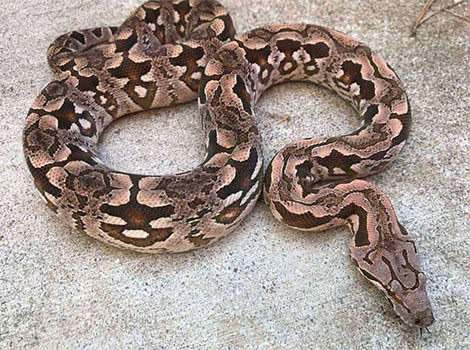
| Attributes | Quick facts |
|---|---|
| Size | 4–6 feet (120–180 cm) |
| Weight | 10–20 pounds (4.5–9 kg) |
| Lifespan | 20–30 years |
| Habitat | Dry forests and scrublands in Madagascar |
| Diet | Small mammals, birds, and reptiles |
| Social Structure | Solitary |
| Conservation | Least Concern |
Fun Fact: Certain tribal communities hold the belief that the spirits of their forebears reside within the skin of a snake.
34. Desert Ghost Ball Python
Desert Ghost Ball Python (Python regius) is a nocturnal species native to West Sub-Saharan Africa, including countries like Senegal, Cameroon, Sudan, and Uganda. It thrives in grasslands, savannas, and sparsely wooded areas.
This snake has a dark-brown or black head with a faded crown, and the stripes through its eyes are more faintly colored compared to a normal Ball Python. Its body starts out with bright yellow coloration that fades with age. The Desert Ghost Ball Python typically reaches lengths ranging from 3 to 5 feet. It is known for its solitary behavior except during mating season.
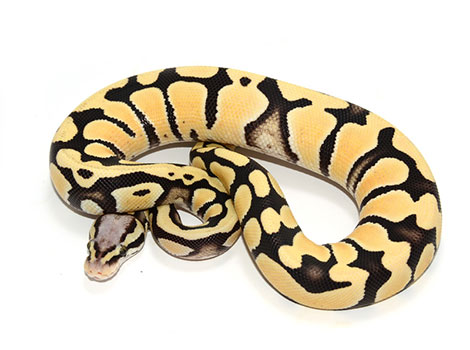
| Attributes | Quick facts |
|---|---|
| Size | 3–5 feet (91–152 cm) |
| Weight | 3–5 lb (1.4–2.3 kg) |
| Lifespan | 20–30 years |
| Habitat | Grasslands, savannas, and sparsely wooded areas in West Sub-Saharan Africa |
| Diet | Small mammals and birds |
| Social Structure | Solitary, except during mating |
| Conservation | Least Concern |
Fun Fact: The desert ghost gene is compatible with many traits and brightens and cleans up patterns.
35. Desert Kingsnake
Desert Kingsnake (Lampropeltis getula splendida) is a species native to Texas, Arizona, and New Mexico in the United States. It can be found in various rural habitats within its range, including woodlands, shrublands, savannas, and grasslands, usually near water tanks or within riparian corridors.
The snake has a glossy dorsum that is black or very dark brown, finely speckled with off-white or yellow. Typically, their growth reaches a length of 3 to 4 feet. However, instances of them achieving a length of up to 6.8 feet have been recorded. Desert Kingsnakes are docile creatures when confronted by humans. If they do not try to escape, they often “play dead” by flipping over onto their backs and lying motionless.
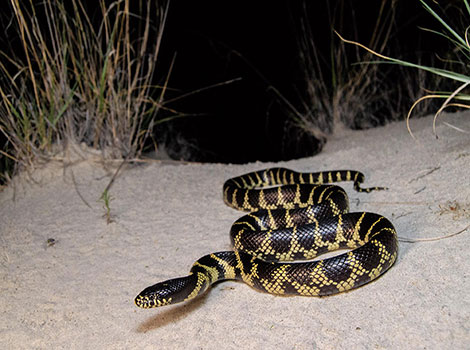
| Attributes | Quick facts |
|---|---|
| Size | 3–4 feet (90–120 cm) |
| Weight | 2–3 pounds (0.9–1.4 kg) |
| Lifespan | 15–20 years |
| Habitat | Deserts, scrublands, grasslands, and forests in the Southwestern United States and Northern Mexico |
| Diet | Small mammals, birds, amphibians, and other snakes (including venomous species) |
| Social Structure | Solitary |
| Conservation | Least Concern |
Fun Fact: Despite being non-venomous, Desert Kingsnakes are known to eat other snakes, including venomous ones.
36. Dwarf Boa
Dwarf Boa (Tropidophis melanurus) is a member of the Tropidophiidae family and is native to regions ranging from Mexico and the West Indies to southeastern Brazil. They have scales that are small and smooth, and their color can vary from brown, grey, yellow, fawn, red, black, white, and tan to olive-grey and grey-brown. The Dwarf Boa grows to lengths between 18 to 24 inches. It is generally docile and known for its calm nature. Most species spend their day burrowed underground or under vegetation, surfacing only at night or when it rains.
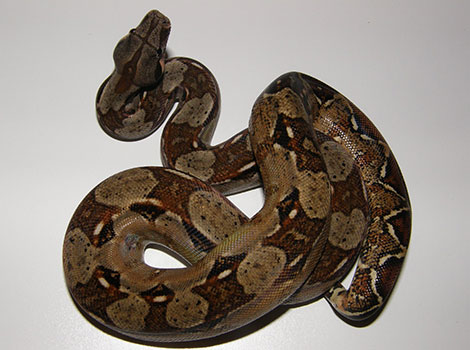
| Attributes | Quick facts |
|---|---|
| Size | 18–24 inches (46–61 cm) |
| Weight | Not readily available |
| Lifespan | 10–20 years |
| Habitat | Forests, grasslands, and burrowed areas across Mexico, the West Indies, and southeastern Brazil |
| Diet | Small mammals, reptiles, and amphibians |
| Social Structure | Solitary |
Fun Fact: The Dwarf Boa can change color from light to dark, and back again.
37. Draco Volans Lizard
Draco Volans Lizard (Flying dragon) is a species of lizard endemic to Southeast Asia. It is found mainly in rain forests and tropical areas that provide an adequate number of trees for the lizard to jump from. The body of Draco Volans is tan in color with dark flecks.
They weigh between 0.73 to 4 ounces. Draco Volans is diurnal, active between 8:00 and 11:00 in the morning, then takes a break until 1:00 p.m. It is known for its ability to glide using winglike lateral extensions of skin called patagia.
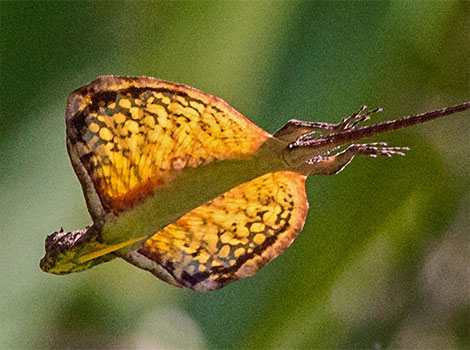
| Attributes | Quick facts |
|---|---|
| Size | 7.5–9 inches (19–23 cm) |
| Weight | 0.73–4 oz (20–113 g) |
| Lifespan | 4–6 years |
| Habitat | Rainforests and tropical areas in Southeast Asia |
| Diet | Ants, termites, and small insects |
| Social Structure | Solitary; territorial |
| Conservation | Least Concern |
Fun Fact: Despite their name and appearance, these lizards don’t actually fly. They glide using skin flaps on their elongated ribs called patagia.
38. Diamond Python
Diamond Python (Morelia spilota) is a medium-sized snake native to Australia. It is typically found in the coastal habitats of southeastern Australia and can also be found in suburban areas, living on the roofs of homes.
The python’s body is dark olive to black with creamy yellow spots. Adult pythons can grow up to 6.6 ft (2 meters) in length, with some reaching up to 13 ft (4 meters). They weigh between 4 to 10 kilograms. Diamond pythons are not very aggressive by nature. They are ambush predators and hibernate in winter.
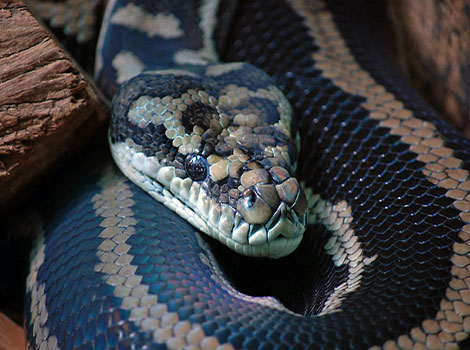
| Attributes | Quick facts |
|---|---|
| Size | 6.6–13 feet (2–4 meters) |
| Weight | 8.8–22 lb (4–10 kg) |
| Lifespan | 20–30 years |
| Habitat | Coastal forests, woodlands, and suburban areas in southeastern Australia |
| Diet | Small mammals, birds, and reptiles |
| Social Structure | Solitary |
| Conservation | Least Concern |
Fun Fact: Diamond pythons live at higher altitudes and further south than any other python species.
39. Desert Tortoise
Desert Tortoise (Gopherus agassizii) is a species native to the southwestern United States and northwestern Mexico. They inhabit various types of habitats, from sandy flats to rocky foothills, and are particularly fond of the Mojave Desert. These tortoises have a high-domed shell that is greenish-tan to dark brown.
They typically measure between 9 and 15 inches in length, weigh between 8–15 pounds (3.6–6.8 kg), and have a height of 10–15 inches (25–38 cm). To maintain their body temperature and minimize dehydration, Desert Tortoises predominantly inhabit burrows, rocky hideouts, and pallets throughout their existence. They are most active after seasonal rains and are inactive during most of the year.
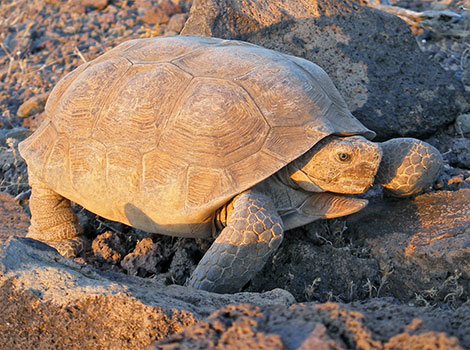
| Attributes | Quick facts |
|---|---|
| Size | 10–15 inches (25–38 cm) |
| Weight | 8–15 pounds (3.6–6.8 kg) |
| Lifespan | 50–80 years |
| Habitat | Deserts, arid scrublands, and rocky hillsides in the Southwestern United States and Northern Mexico |
| Diet | Grasses, wildflowers, cacti, and other vegetation |
| Social Structure | Primarily solitary but may share burrows |
| Conservation | Vulnerable |
Fun Fact: Desert Tortoises can go up to a year without requiring fresh water again.
40. Dwarf Crocodile
The dwarf crocodile (African dwarf crocodile), a member of the crocodile family (Crocodylidae), inhabits the regions of sub-Saharan West Africa and Central Africa. These reptiles typically boast a dark brown or black body with a contrasting yellowish underside.
Their stocky build is protected by bony plates running along their back, while their snout is relatively short and blunt. Reaching lengths of 4.9–5.9 feet (1.5–1.8 meters) and weighing between 40–71 lb (18–32 kg) as adults, they are primarily nocturnal. During the day, they seek shelter in burrows or under dense vegetation, becoming active hunters at night.
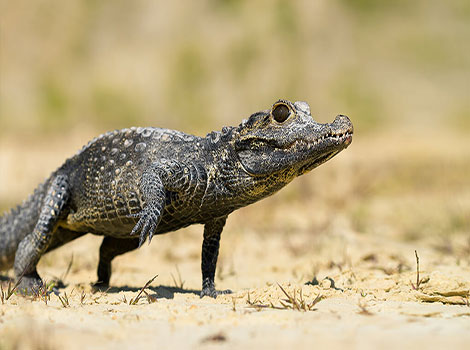
| Attributes | Quick facts |
|---|---|
| Size | 4.9–5.9 feet (1.5–1.8 meters) |
| Weight | 40–71 lb (18–32 kg) |
| Lifespan | 50–100 years |
| Habitat | Forested wetlands, swamps, and slow-moving rivers in sub-Saharan West and Central Africa |
| Diet | Fish, amphibians, crustaceans, and small mammals |
| Social Structure | Solitary |
| Conservation | Vulnerable |
Fun Fact: They are known to live between 50 to 100 years, making them one of the longest-living crocodile species.
From the sun-soaked habitats of reptiles, we move to the skies, where birds starting with ‘D’ exhibit their own stunning array of colors, songs, and flight patterns.
Birds that start with D
Birds like ducks, doves, and drongos captivate with their beauty, intelligence, and ecological roles, demonstrating the immense diversity found in avian species that start with ‘D.’
| D’Uccle Chicken | Dickinson’s Kestrel | Dolphin Gull |
| Dickcissel | Downy Woodpecker | Drongo |
| Dark-Eyed Junco | Dunnock | Dracula Parrot |
| Diving Duck | Dorking Chicken |
41. D’Uccle Chicken
D’Uccle Chicken (Belgian Bantam) is a diminutive chicken breed from Uccle, a town near Brussels in Belgium. This chicken comes in various colors, including millefleur, black mottled, and white. They stand only 8–10 inches (20–25 cm) tall and weigh between 1.5–2.2 lb (0.7–1 kg), these chickens are known for their friendly and docile nature. These chickens are well-suited to life in a backyard environment and can be kept in a coop or small barn.
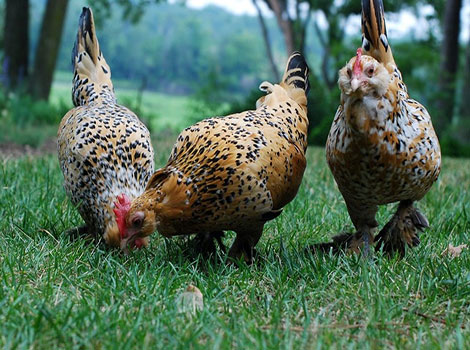
| Attributes | Quick facts |
|---|---|
| Size | 8–10 inches (20–25 cm) |
| Weight | 1.5–2.2 lb (0.7–1 kg) |
| Lifespan | 5–8 years |
| Habitat | Domesticated; farms and backyards |
| Diet | Grains, seeds, insects, and vegetable scraps |
| Social Structure | Flocks |
| Conservation | Watchlist |
Fun Fact: They often mistaken for similar breeds, including the Booted Bantam, Sablepoot, and Bearded Antwerp.
42. Dickinson’s Kestrel
Dickinson’s kestrel (Falco dickinsoni), also known as a hawk or bird of prey, primarily inhabits savannas such as Acacia savannas and open woodlands like Miombo woodlands in southern and eastern Africa. It exhibits a particular fondness for marshy areas bordering bodies of water.
Compared to other kestrels, it has a compact build with a prominent, rectangular-shaped head. The American kestrel is about 11–12 in (28–30 cm) in length; wingspan 24–27 in (61–69 cm). The predominantly dark gray plumage features a contrasting light-colored head and rump. Its diet consists mainly of large insects, including grasshoppers, but may also encompass other invertebrates like beetles and crickets.
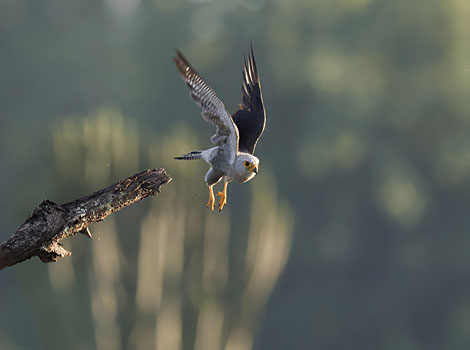
| Attributes | Quick facts |
|---|---|
| Size | 11–12 in (28–30 cm); wingspan 24–27 in (61–69 cm) |
| Weight | 5–8 oz (150–230 g) |
| Lifespan | 5–10 years in the wild |
| Habitat | Wooded savannas and open grasslands in sub-Saharan Africa |
| Diet | Insects, small reptiles, birds, and rodents |
| Social Structure | Solitary or in pairs |
| Conservation | Least Concern |
Fun Fact: It is often attracted to grass fires where it preys on fleeing insects and other prey.
43. Dolphin Gull
Dolphin Gull (Larus scoresbii) is a coastal bird that inhabits rocky coasts. It has a uniform pale grey head and upperparts, with a darker mantle. The heavy bill and fairly short legs are bright red. The Dolphin Gull has a length of 17–19 inches (43–48 cm, and weighs around 0.9–1.3 lb (400–600 g). This bird is a scavenger and opportunistic predator, feeding on carrion, offal, bird eggs, nestlings, and marine invertebrates.
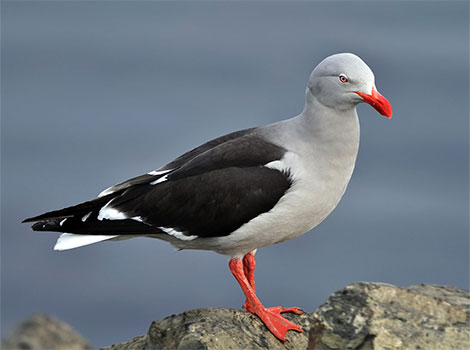
| Attributes | Quick facts |
|---|---|
| Size | 17–19 inches (43–48 cm) |
| Weight | 0.9–1.3 lb (400–600 g) |
| Lifespan | 10–20 years |
| Habitat | Coastal areas and islands in southern South America |
| Diet | Scavenger; feeds on carrion, fish, and invertebrates |
| Social Structure | Colonies or small groups |
| Conservation | Least Concern |
Fun Fact: The Dolphin Gull’s scientific name commemorates the English explorer William Scoresby.
44. Dickcissel
Dickcissel (Spiza americana) a North American grassland bird belonging to the Cardinalidae family, is primarily found in the Midwestern United States, including Kansas, Oklahoma, and Nebraska. The bird has a large, pale bill, a yellow line over the eyes, brownish upper parts with black streaks on the back, dark wings, and a rust patch on the shoulders. The Dickcissel measures between 6–6.3 inches (15–16 cm) in length and weighs 0.9–1.4 oz (26–40 g). The bird forms enormous flocks during migration.
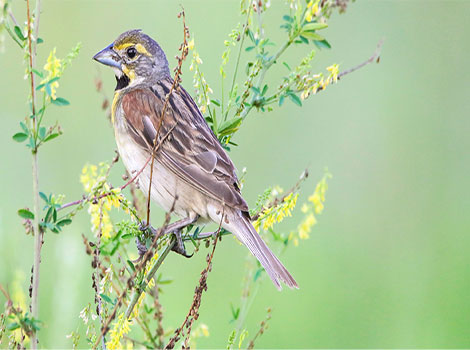
| Attributes | Quick facts |
|---|---|
| Size | 6–6.3 inches (15–16 cm) |
| Weight | 0.9–1.4 oz (26–40 g) |
| Lifespan | 4–6 years |
| Habitat | Grasslands, prairies, and agricultural fields in North and Central America |
| Diet | Seeds and insects |
| Social Structure | Small flocks, especially during migration |
| Conservation | Least Concern |
Fun Fact: The speed of the Dickcissel’s flight is estimated up to 37.5 mph (60 kph).
45. Downy Woodpecker
Downy Woodpecker (Dryobates pubescens) is a member of the Picidae family and is native to forested regions across the United States and Canada. This bird is a body length of 5.5–6.7 inches (14–17 cm), a wingspan of 25 to 31 cm (9.8 to 12.2 in), and a weight between 0.74 and 1 ounce (21-28 g). Its plumage is black on the upper parts and wings, contrasted by a white back, throat, and belly, and white spotting on the wings. The Downy Woodpecker is a diurnal and territorial bird.
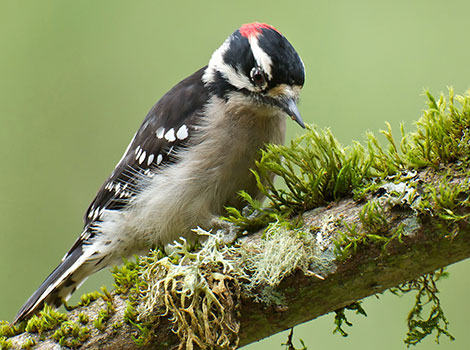
| Attributes | Quick facts |
|---|---|
| Size | 5.5–6.7 inches (14–17 cm) |
| Weight | 0.7–1 oz (20–28 g) |
| Lifespan | 4–11 years |
| Habitat | Forests, orchards, and urban areas across North America |
| Diet | Insects, seeds, and berries |
| Social Structure | Solitary or pairs during breeding season |
| Conservation | Least Concern |
Fun Fact: Downy Woodpeckers can peck 20 times per second.
46. Drongo
The Drongo (Dicrurus) is a medium-sized bird that inhabits various tropical regions. They are typically found in diverse habitats, from dense forests and woodlands to open savannas and agricultural areas. Drongos are generally black or dark gray, with a metallic sheen.
They measure between 7–14 inches (18–36 cm) in length, with a wingspan ranging from 0.7–5 oz (20–140 g). They usually weigh about 50 grams. Drongos are active, diurnal birds, known for their agility and acrobatic skills in flight. Drongos are generally solitary or found in pairs, especially during the breeding season.
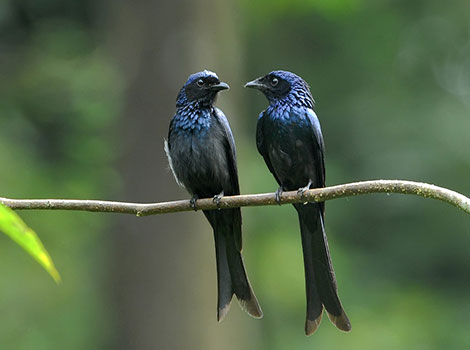
| Attributes | Quick facts |
|---|---|
| Size | 7–14 inches (18–36 cm) |
| Weight | 0.7–5 oz (20–140 g) |
| Lifespan | 10–15 years |
| Habitat | Forests, savannas, and open woodlands in Asia, Africa, and Australia |
| Diet | Insects, small birds, and fruits |
| Social Structure | Solitary or pairs |
| Conservation | Least Concern |
Fun Fact: They can mimic other birds and animals, which makes the other species respond to the calls of this bird.
47. Dark-Eyed Junco
Dark-Eyed Junco (Snowbird) is a member of the Passerellidae family and is found in North America. This bird exhibits a variety of colors, with its eyes being dark, beaks pink, tails edged with white, and hoods that can be black, brown, or gray. They range from 5.1–6.3 inches (13–16 cm) in length, with a wingspan of 0.6–1 oz (18–28 g), and it weighs between 18 to 30 grams. They often forage in groups, especially during the winter season.
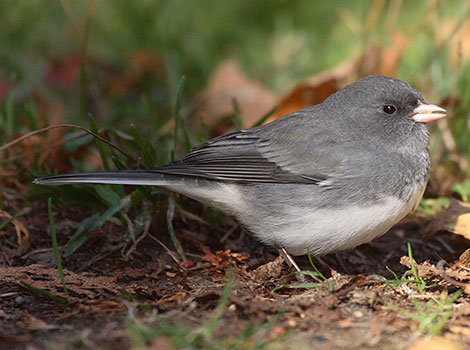
| Attributes | Quick facts |
|---|---|
| Size | 5.1–6.3 inches (13–16 cm) |
| Weight | 0.6–1 oz (18–28 g) |
| Lifespan | 3–11 years |
| Habitat | Forests, fields, and suburban areas across North America |
| Diet | Seeds, insects, and berries |
| Social Structure | Small flocks, especially in winter |
| Conservation | Least Concern |
Fun Fact: They are often referred to as a “snow bird” due to their tendency to appear at backyard feeders during the winter months.
48. Dunnock
Dunnock (Hedge Sparrow) is a member of the Prunellidae family. Its habitat spans across Eurasia, including large parts of Europe, Lebanon, northern Iran, and the Caucasus. The Dunnock is a brown, grey plumage and a slender beak. The bird measures 14 cm in length, with a wingspan ranging 5.3–5.5 inches (13.5–14 cm) cm and weight falls between 0.63–0.74 oz (18–21 g). They are diurnal creatures, feeding mostly on the ground. They are territorial birds, particularly during the breeding season, and may engage in conflicts with other birds that invade their nests.
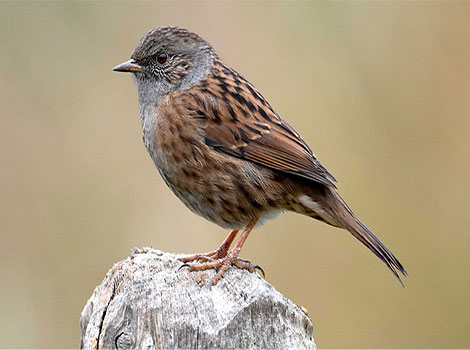
| Attributes | Quick facts |
|---|---|
| Size | 5.3–5.5 inches (13.5–14 cm) |
| Weight | 0.63–0.74 oz (18–21 g) |
| Lifespan | 2–3 years (up to 10 years in rare cases) |
| Habitat | Woodlands, gardens, and hedgerows in Europe and western Asia |
| Diet | Insects, spiders, and seeds |
| Social Structure | Solitary or small territorial groups |
| Conservation | Least Concern |
Fun Fact: Dunnocks have been victims of cuckoo parasitism for at least the last 600 years.
49. Dracula Parrot
The Dracula parrot (Psittrichas fulgidus), a striking inhabitant of the mountainous rainforests of New Guinea, possesses a unique and unfeathered head, earning it its namesake. This large parrot boasts a prominent, hooked beak and a comparatively oversized head, contributing to its vulture-like appearance. Its plumage is predominantly black, adorned with delicate gray scales on the chest and a contrasting vibrant red belly. Adults typically reach an impressive length of around 18–20 inches (46–51 cm) and weigh between 1.5–1.8 lb (680–800 g). Renowned for their distinctive vocalizations, these parrots emit a series of harsh, raspy, and guttural calls that can be heard over long distances, particularly during dawn and dusk.
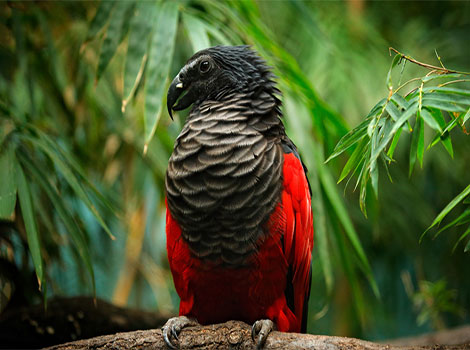
| Attributes | Quick facts |
|---|---|
| Size | 18–20 inches (46–51 cm) |
| Weight | 1.5–1.8 lb (680–800 g) |
| Lifespan | 20–40 years |
| Habitat | Montane rainforests in New Guinea |
| Diet | Primarily figs and other fruits |
| Social Structure | Pairs or small groups |
| Conservation | Vulnerable |
Fun Fact: It has evolved to lose the feathers on its head so that it doesn’t get messy with the sticky syrup of figs.
50. Diving Duck
Diving Duck (Sea Duck) is a member of the Anatidae family and is native to the Northern Hemisphere. It lives in lake, pond, river, heating. This species has a compact and fusiform body, which is wider in the middle and tapering toward the end. They have a multi-colored plumage, with males often displaying contrasting dark and lighter colors. They range from 16–24 inches (40–61 cm) in long and weigh between 1.3–3.5 lb (600–1,600 g). They are agile swimmers and can dive far beneath the surface of the water to get food, including small fishes, and aquatic plants.
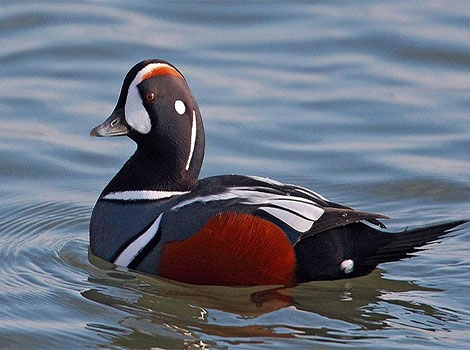
| Attributes | Quick facts |
|---|---|
| Size | 16–24 inches (40–61 cm) |
| Weight | 1.3–3.5 lb (600–1,600 g) |
| Lifespan | 10–15 years |
| Habitat | Lakes, rivers, and coastal waters in North America, Europe, and Asia |
| Diet | Aquatic plants, insects, mollusks, and small fish |
| Social Structure | Flocks, especially during migration |
| Conservation | Least Concern |
Fun Fact: Diving Ducks often dive more frequently and for longer periods during the night.
51. Dorking Chicken
Dorking Chicken (5-Toed Chicken) is a domesticated chicken breed that traces its roots back to Surrey, the United Kingdom. They measures about 18 to 22 inches (46–56 cm) in length and typically weighs between 7 to 14 pounds (3–6.5 kg).They have a robust build, short legs, and large comb, which can appear floppy in roosters, and their fur in white and silver-grey color varieties. These chickens weigh in at around 8lbs. They are used for both egg and meat production.
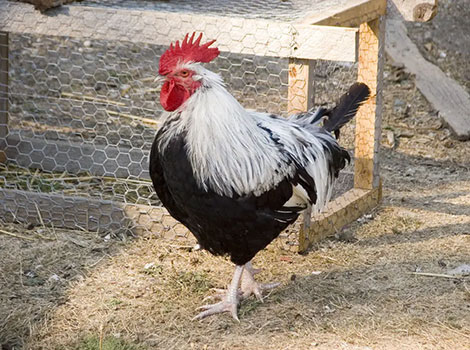
| Attributes | Quick facts |
|---|---|
| Size | 18–22 inches (46–56 cm) |
| Weight | 7–14 lb (3–6.5 kg) |
| Lifespan | 5–8 years |
| Habitat | Domesticated; farms and backyards |
| Diet | Grains, seeds, insects, and vegetable scraps |
| Social Structure | Flocks |
| Conservation | At Risk |
Fun Fact: The Dorking Chicken is one of the few breeds that has a fifth toe.
After marveling at the avian wonders, let’s dive into the aquatic world. Fish that start with ‘D’ bring to life the vibrant and diverse ecosystems beneath the water’s surface.
Fish that start with D
Fish such as dogfish and damselfish highlight the fascinating variety of aquatic life, with each species adapted to thrive in its unique underwater environment.
| Dabra Goby | Dwarf Gourami | Dusky Dolphin |
| Drum Fish | Discus | Damselfish |
| Dragon Eel | Dartfish | Dusty Grouper |
| Dusky Shark |
52. Dara Goby
Dabra Goby (Cryptocentrus cinctus) is a small marine creature that can be found in the reef-associated waters of the Western Pacific, specifically in Palau. This species has a maximum length of 1.2–1.6 inches (3–4 cm), making it a relatively tiny inhabitant of the ocean. Its body displays a strong dark bar, beginning just anterior to the origin of the first dorsal fin and passing ventrally just behind the base of the pectoral fin. This bar is about equal in width to the eye diameter. The Dabra Goby is also characterized by a dark anteroventrally-directed wedge-shaped bar from the eye to the jaws. As for its behavior, like most gobies, it is a bottom-dweller.
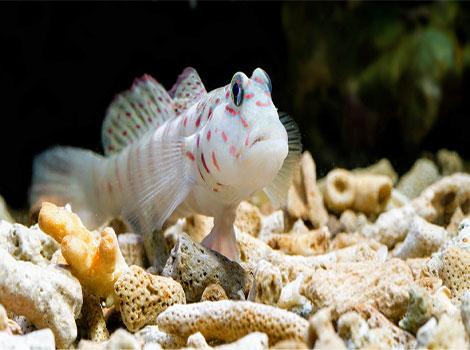
| Attributes | Quick facts |
|---|---|
| Size | 1.2–1.6 inches (3–4 cm) |
| Weight | 0.004–0.007 oz (0.1–0.2 g) |
| Lifespan | 1–2 years |
| Habitat | Freshwater streams in Southeast Asia |
| Diet | Small invertebrates and detritus |
| Social Structure | Solitary or small groups |
| Conservation | Data Deficient |
Fun Fact: Despite its small size, it is known to be a strong swimmer, capable of navigating the vast ocean currents
53. Dwarf Gourami
Dwarf Gourami (Trichogaster lalius) is native to South Asia, particularly India, Bangladesh, and Myanmar. It inhabits slow-moving waters, rice fields, and marshes with dense vegetation. Dwarf Gouramis have compressed bodies and large, rounded fins. Males are typically larger and much more colorful than females, with vibrant hues of blue, red, and orange. They can grow to be up to 4.5 inches, but on average most of them only reach around 3.5 inches.
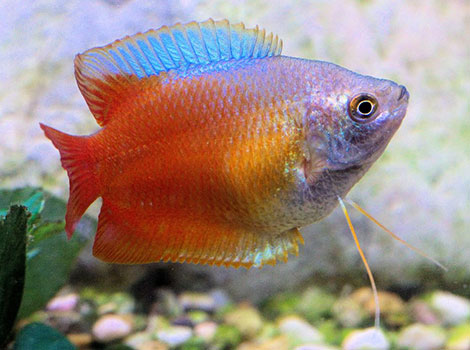
| Attributes | Quick facts |
|---|---|
| Size | 2–3.5 inches (5–9 cm) |
| Weight | 0.1–0.2 oz (3–6 g) |
| Lifespan | 4–6 years |
| Habitat | Slow-moving rivers, ponds, and rice paddies in South Asia |
| Diet | Algae, plant matter, and small invertebrates |
| Social Structure | Pairs or small groups |
| Conservation | Least Concern |
Fun Fact: They can develop a labyrinth organ that allows them to breathe oxygen from the surface of the water.
54. Dusky Dolphin
Dusky Dolphin (Lagenorhynchus obscurus) is found in the coastal waters of the Southern Hemisphere, with significant populations around South America, southwestern Africa, and New Zealand. These animals have a dusky bluish-black color on their back and tail, and a dark streak that stretches diagonally across the flanks to the tail. They measure between 5–6.6 feet (1.5–2 m) in length and weigh between 150–190 lb (70–90 kg). They are very social, fast-swimming, and agile. They are always on the go, performing high jumps, tumbles, and twists.
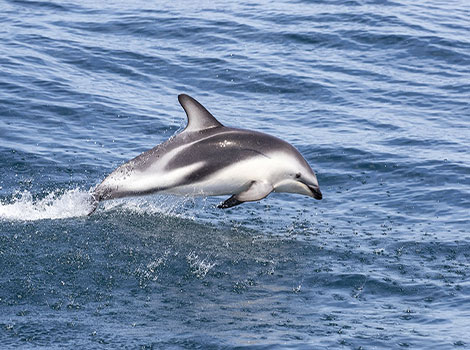
| Attributes | Quick facts |
|---|---|
| Size | 5–6.6 feet (1.5–2 m) |
| Weight | 150–190 lb (70–90 kg) |
| Lifespan | 20–25 years |
| Habitat | Coastal waters in the Southern Hemisphere |
| Diet | Fish, squid, and krill |
| Social Structure | Large pods (up to 1,000 individuals) |
| Conservation | Least Concern |
Fun Fact: Dusky dolphins often swim up to boats when they notice one.
55. Drum Fish
Drum Fish (Sciaenidae) is a carnivorous fish that can be found in both freshwater and saltwater environments. They are typically found in North and Central America, inhabiting the bottom of rivers and preferring slow-moving waters full of mud. Physically, Drum Fish have a long body with a divided dorsal fin running along their back. They can grow up to 10–35 inches (25–90 cm) in length and weigh up to 1–60 lb (0.5–27 kg). Their color varies from brown, red, black, and white, to silver. Drum Fish are known for their unique behavior of making a croaking sound with their swimming bladder.
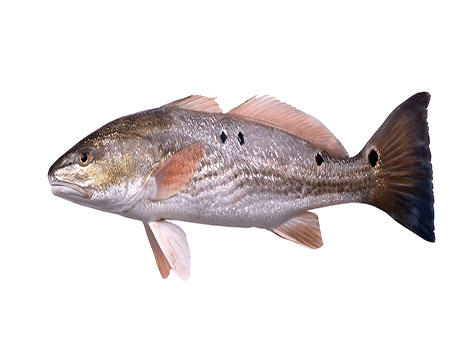
| Attributes | Quick facts |
|---|---|
| Size | 10–35 inches (25–90 cm) |
| Weight | 1–60 lb (0.5–27 kg, varies by species) |
| Lifespan | 6–50 years (species-dependent) |
| Habitat | Freshwater and coastal marine waters worldwide |
| Diet | Small fish, crustaceans, and mollusks |
| Social Structure | Solitary or small groups |
| Conservation | Least concern |
Fun Fact: They are also called drums or croakers because of the sound they make with their swimming bladders.
56. Discus
Discus (Symphysodon) is a tropical fish that resides in the long, sinewy waterways of the Amazon Basin. They are brightly colored and have a disc-shaped body that is laterally compressed. The size varies based on the species and where they live. Individuals kept in domestic aquariums often attain greater dimensions to their counterparts in the wild. Generally, these fish measure between 4.8–6 inches (12–15 cm).
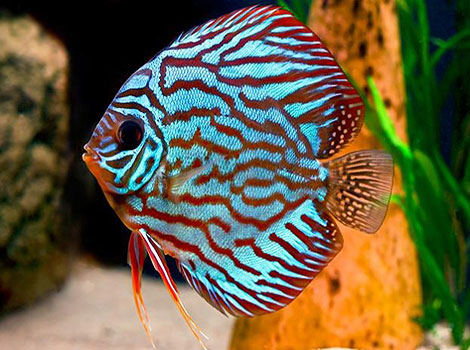
| Attributes | Quick facts |
|---|---|
| Size | 4.8–6 inches (12–15 cm) |
| Weight | 0.9–1.5 oz (25–43 g) |
| Lifespan | 10–15 years |
| Habitat | Slow-moving rivers and floodplains in the Amazon Basin |
| Diet | Algae, plant matter, and small invertebrates |
| Social Structure | Small schools or pairs |
| Conservation | Least Concern |
Fun Fact: Discus fish prefer to congregate in large groups with dozens of members for protection and feeding.
57. Damselfish
Damselfish (Demoiselle) thrives in the Atlantic and Indo-Pacific oceans. These creatures are to inhabit tropical, subtropical, and temperate waters, with a particular affinity for tropical rocky or coral reefs. The Damselfish has color diverse, ranging from shades of red, orange, yellow, or blue.
They grow to around 2–12 inches (5–30 cm) in length. Their territorial nature, especially during breeding seasons when males aggressively defend their nesting sites. Their diet varies, with some feeding mainly on plant matter or small animals suspended in the water, while others are omnivorous.
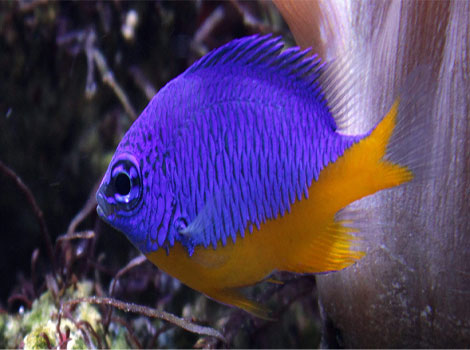
| Attributes | Quick facts |
|---|---|
| Size | 2–12 inches (5–30 cm, varies by species) |
| Weight | 0.1–0.8 oz (3–23 g) |
| Lifespan | 5–15 years |
| Habitat | Coral reefs and rocky coastal areas in tropical and subtropical oceans |
| Diet | Algae, plankton, and small invertebrates |
| Social Structure | Solitary or small territorial groups |
| Conservation | Least Concern |
Fun Fact: They use distinct popping and chirping sounds to communicate with other damselfish in their territory.
58. Dragon Eel
Dragon Eel (Enchelycore pardalis) is a striking marine creature. It is primarily found in the Indo-Pacific Ocean, including the coasts of Japan, New Caledonia, Fiji, and Australia. This eel is known for its vibrant colors, with a body covered in orange, red, yellow, white, and black markings.
It has a muscular, long body with a flattened tail that resembles an oar. The Dragon Eel can grow up to 2–12 inches (5–30 cm in length. As for its behavior, it is a nocturnal predator, often hiding away in rocky crevices and outcrops until nightfall, when it emerges to hunt.
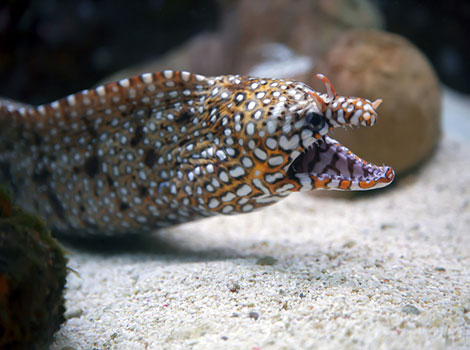
| Attributes | Quick facts |
|---|---|
| Size | 24–36 inches (60–90 cm) |
| Weight | 2–5 lb (0.9–2.3 kg) |
| Lifespan | 10–15 years |
| Habitat | Coral reefs and rocky crevices in the Indo-Pacific region |
| Diet | Fish and small crustaceans |
| Social Structure | Solitary |
| Conservation | Least Concern |
Fun Fact: They have double jaws and two sets of razor-sharp teeth.
59. Dartfish
Dartfish (Nemateleotris magnifica) is a member of the Gobiidae family and is native to the Indo-Pacific Ocean. The Dartfish is a small fish, measuring around 4 inches in length. Its body is elongated and slender, resembling an eel, and it boasts a vibrant array of colors including orange, red, yellow, blue, green, purple, and black. They are a suitable addition to most community aquariums, provided it is not kept with larger, more aggressive species that could pose a threat.
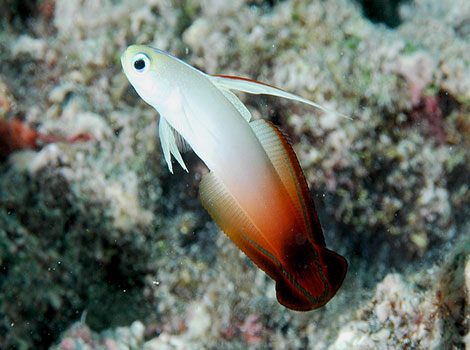
| Attributes | Quick facts |
|---|---|
| Size | 2–4 inches (5–10 cm) |
| Weight | 0.03–0.07 oz (1–2 g) |
| Lifespan | 5–6 years |
| Habitat | Coral reefs and sandy seabeds in tropical oceans |
| Diet | Plankton and small invertebrates |
| Social Structure | Pairs or small groups |
| Conservation | Least Concern |
Fun Fact: Dartfish are diurnal planktivorous feeders, darting back to their burrow after capturing plankton from the water column.
60. Dusty Grouper
Dusty Grouper (Epinephelus marginatus) is a marine species usually found in and around rocky reefs, from surface waters down to 300 meters in depth. It has a large, oval body and a large head with a wide mouth that has a protruding lower jaw.
The head and upper body are colored dark reddish-brown or greyish, usually with yellowish-gold countershading on the ventral surfaces. This species can grow up to 150 cm in length but is more often 20–40 inches (50–100 cm). It can weigh up to 10–55 lb (4.5–25 kg). The Dusty Grouper is an opportunistic predator, mainly operating during twilight hours.
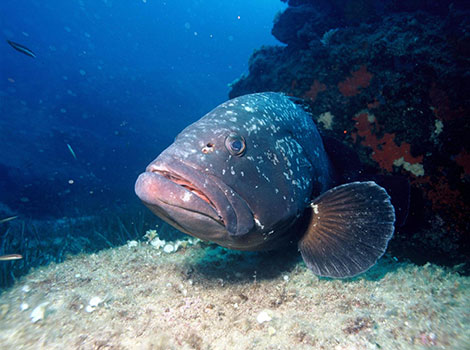
| Attributes | Quick facts |
|---|---|
| Size | 20–40 inches (50–100 cm) |
| Weight | 10–55 lb (4.5–25 kg) |
| Lifespan | 30–50 years |
| Habitat | Rocky reefs and coastal waters in the Mediterranean and Eastern Atlantic |
| Diet | Fish, crustaceans, and mollusks |
| Social Structure | Solitary |
| Conservation | Vulnerable |
Fun Fact: They are protogynous hermaphrodites, meaning all females turn into males at around 10 years of age.
61. Dusky Shark
Dusky Shark (Carcharhinus obscurus) is a large ocean predator that can be found in tropical and subtropical waters worldwide. It has a streamlined body, a rounded snout, and sickle-shaped pectoral fins. The color of this shark is typically gray or brown, with a lighter underbelly.
It can grow up to 14 feet in length and weigh up to 800 pounds. This species is known for its slow growth rate, taking around 20 years to reach adulthood. They are also known for their seasonal migrations, moving north or south as temperatures rise and drop.
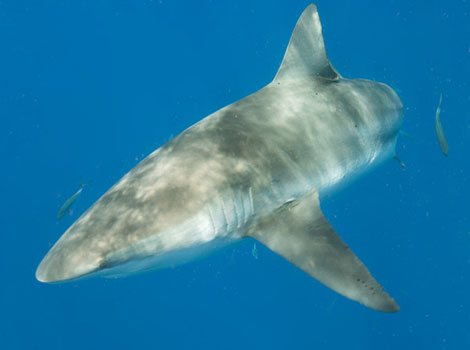
| Attributes | Quick facts |
|---|---|
| Size | 10–14 feet (3–4.3 m) |
| Weight | 400–800 lb (180–360 kg) |
| Lifespan | 30–50 years |
| Habitat | Coastal and offshore waters in temperate and tropical oceans |
| Diet | Fish, squid, crustaceans, and smaller sharks |
| Social Structure | Solitary or small groups |
| Conservation | Endangered |
Fun Fact: Dusky sharks have the strongest bite force among all modern sharks, exerting 130 lb over a 0.0031 in 2 area at the tip of a tooth.
From underwater dwellers, we leap to amphibians. Animals that bridge land and water, amphibians starting with ‘D’ are equally captivating and ecologically significant.
Amphibians that start with D
Amphibians like the dart frog and dusky salamander demonstrate the extraordinary adaptations of creatures living in both aquatic and terrestrial environments.
| Dart Poison Frog | Dyeing Poison Dart Frog | Danube Crested Newt |
| Darwin’s Frog | Desert Rain Frog |
62. Dart Poison Frog
Dart Poison Frog (Dendrobatidae) is a member of the Dendrobatidae family and is indigenous to the humid, tropical rainforests of Central and South America. They range from black, brown, tan, and muddy green in less poisonous species to bright yellow, blue, red, orange, and bright green in highly toxic species. They measure 0.6–2.4 inches (1.5–6 cm) in adult length and they weigh around 0.004–0.07 oz (0.1–2 g). These diurnal creatures are for their boldness and territorial nature, especially among males.
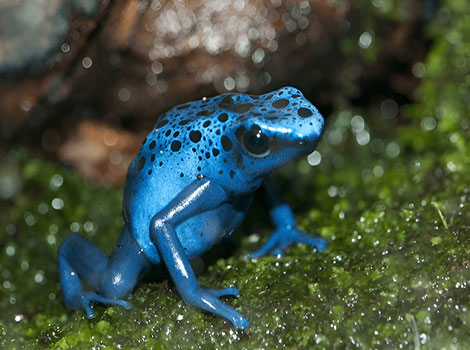
| Attributes | Quick facts |
|---|---|
| Size | 0.6–2.4 inches (1.5–6 cm) |
| Weight | 0.004–0.07 oz (0.1–2 g) |
| Lifespan | 4–8 years |
| Habitat | Tropical rainforests in Central and South America |
| Diet | Ants, mites, and small insects |
| Social Structure | Solitary or small groups |
| Conservation | Least Concern |
Fun Fact: Dart Poison Frogs are immune to their poison.
63. Dyeing Poison Dart Frog
Dyeing Poison Dart Frog (Dendrobates tinctorius) is native to the northeastern part of South America, including countries like Guyana, Brazil, Suriname, and French Guiana. This species is known for its vibrant skin, with a blue belly and legs, and a back that is colored yellow and black.
It is among the largest species of poison dart frogs, typically reaching lengths of about 1.2–2 inches (3–5 cm). The average weight for males is 3.7g (0.13oz) and females are almost double this weight at 0.07–0.11 oz (2–3 g). They are diurnal, active during the day, and are very social, often staying in pairs or groups. They feed on small insects like ants and termites.
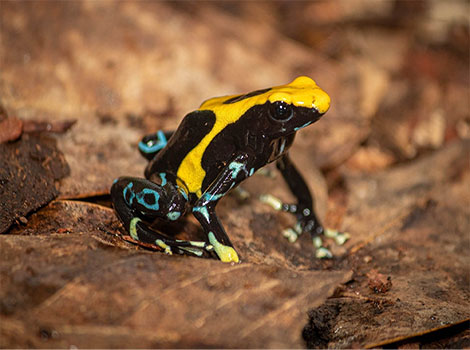
| Attributes | Quick facts |
|---|---|
| Size | 1.2–2 inches (3–5 cm) |
| Weight | 0.07–0.11 oz (2–3 g) |
| Lifespan | 10–15 years |
| Habitat | Tropical rainforests in South America |
| Diet | Ants, termites, and small insects |
| Social Structure | Solitary or small groups |
| Conservation | Least Concern |
Fun Fact: Myths say that these frogs were once used to turn the feathers of green parrots from green to red.
64. Danube Crested Newt
Danube Crested Newt (Triturus dobrogicus) is a species of newt found in central and eastern Europe, along the basin of the Danube river and some of its tributaries and in the Dnieper delta. It inhabits floodplains and wetlands of lowland rivers, backwaters, oxbows, ponds, lakes, canals, and ditches.
Measuring 4.7–7.9 inches (12–20 cm) long in total. This species is characterized by its slim, extended physique, which is well-suited for swimming, complemented by a tapered head and comparatively shorter appendages. Its back and sides are dark brown with black spots and white stippling. The belly is orange to red.
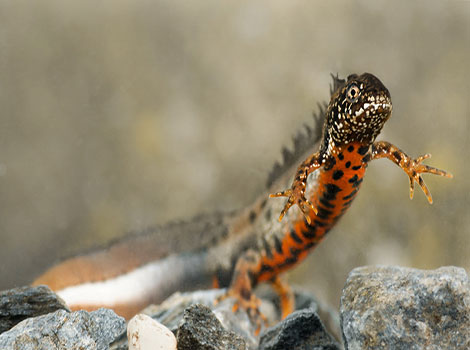
| Attributes | Quick facts |
|---|---|
| Size | 4.7–7.9 inches (12–20 cm) |
| Weight | 0.3–0.7 oz (8–20 g) |
| Lifespan | 12–15 years |
| Habitat | Ponds, lakes, and slow-moving water in Central and Eastern Europe |
| Diet | Insects, worms, and small aquatic animals |
| Social Structure | Solitary |
| Conservation | Near Threatened |
Fun Fact: Of all the species of crested newts, the Danube crested newt is the smallest.
65. Darwin’s Frog
Darwin’s Frog (Rhinoderma darwinii) lives the temperate forests of Chile and Argentina. The frog’s with a snout-to-vent length of 0.8–1.2 inches (2–3 cm0.07–0.14 oz (2–4 g). Its coloration varies from brown to green, mimicking the appearance of leaves. They active during the day, and have a knack for remaining motionless to blend into the leaf litter and evade predators. They are solitary, only congregating during the breeding season.
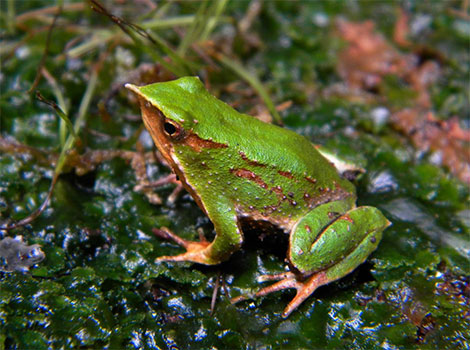
| Attributes | Quick facts |
|---|---|
| Size | 0.8–1.2 inches (2–3 cm) |
| Weight | 0.07–0.14 oz (2–4 g) |
| Lifespan | 10–15 years |
| Habitat | Temperate forests and wetlands in Chile and Argentina |
| Diet | Insects and small invertebrates |
| Social Structure | Solitary |
| Conservation | Endangered |
Fun Fact: Darwin’s Frog raise its young in the male’s vocal sac instead of in water.
66. Desert Rain Frog
Desert Rain Frog (Namaqua Rain Frog) is a stubby amphibian endemic to the arid sandy shores and dunes of Namibia and South Africa. This frog has a plump body with bulging eyes, a short snout, short limbs, spade-like feet, and webbed toes. It can be between 2–2.4 inches (5–6 cm) long. The color of this frog is yellowish-brown. It is nocturnal, spending the day in a burrow where the sand is moist. It makes its appearance during both misty and clear nights, roaming across the expanse of the dunes.
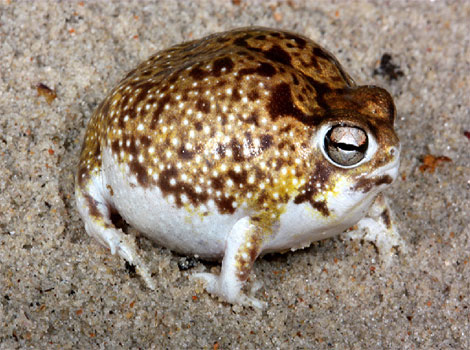
| Attributes | Quick facts |
|---|---|
| Size | 2–2.4 inches (5–6 cm) |
| Weight | 0.4–0.7 oz (11–20 g) |
| Lifespan | 4–6 years |
| Habitat | Coastal sand dunes in Namibia and South Africa |
| Diet | Insects and small invertebrates |
| Social Structure | Solitary |
| Conservation | Vulnerable |
Fun Fact: Unlike most frogs, Desert Rain Frogs develop directly from the egg into adults without passing through the tadpole stage.
Leaving the amphibians’ world, we now turn our focus to insects. These small yet vital creatures starting with ‘D’ play crucial roles in ecosystems worldwide.
Insects that start with D
Insects like dragonflies and damselflies captivate with their elegance and importance in pollination, pest control, and maintaining biodiversity across various ecosystems.
| Deadleaf Mantis | Dog Tick | Dried Fruit Moth |
| Deathwatch Beetle | Desert Locust | Diamondback Moth |
| Dubia Cockroach | Death’s Head Cockroach | Darkling Beetle |
| Dung Beetle | Dobsonfly | Devil’s Coach Horse Beetle |
67. Deadleaf Mantis
Deadleaf Mantis (Deroplatys desiccata) is a species of praying mantis that inhabits the humid tropical forests of Southeast Asia, including Thailand, Malaysia, Indonesia, and Sumatra. It has a unique appearance that resembles a dead leaf, with various shades of brown. It can reach 2–4 in (5–10 cm), depending on species. They are ambush predators, often found on the ground among dead leaves, on tree barks, or swinging on branches or vines.
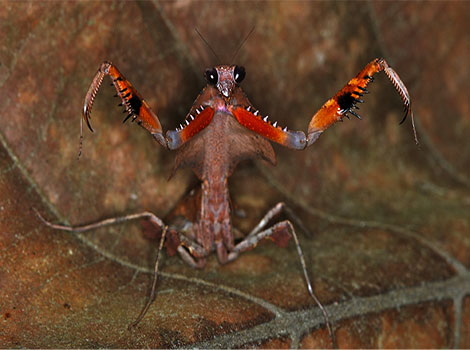
| Attributes | Quick facts |
|---|---|
| Size | 2–4 in (5–10 cm), depending on species |
| Weight | Approximately 0.1–0.2 oz (3–6 g) |
| Lifespan | 6–12 months |
| Habitat | Tropical forests and wooded areas in Southeast Asia |
| Diet | Carnivorous; feeds on insects and small invertebrates |
| Social Structure | Solitary |
| Conservation | Least Concern |
Fun Fact: When threatened, the Deadleaf Mantis can fall to the ground and lie motionless, mimicking a real dead leaf.
68. Dog Tick
Dog Tick (Wood Tick) habitats across areas abundant in woods, shrubs, and long grass. The Dog Tick has a rounded body and eight legs, with a color palette that ranges from red-brown to beige. Its size varies between 5 mm and 15 mm, contingent on whether it has fed on host blood. When foraging, they position themselves on a leaf or blade of long grass, awaiting a host to brush against it and latching onto the host with its legs.
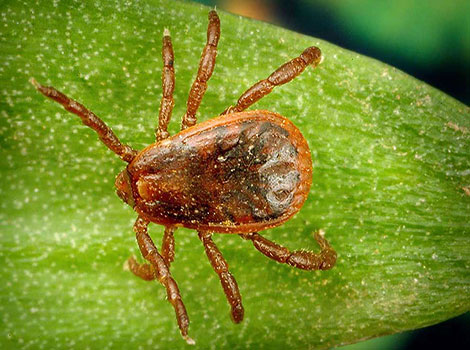
| Attributes | Quick facts |
|---|---|
| Size | 0.12–0.6 inches (3–15 mm) |
| Weight | 0.00007–0.04 oz (2–1.2 g) |
| Lifespan | 2–3 years |
| Habitat | Forests, grasslands, urban areas |
| Diet | Blood from animals |
| Social Structure | Solitary |
| Conservation | Not a concern |
Fun Fact: American Dog tick larvae can survive up to 540 days without a meal.
69. Dried Fruit Moth
Dried Fruit Moth (Cadra calidella) is a species of snout moth that lives in warmer climates, primarily in the Mediterranean region. These brownish-gray moths have pepper-like markings with segmented abdomens. Females are larger than males, featuring a wingspan of 0.5–0.8 in (13–20 mm). They feed on dried fruits and carob pods and are considered a storage food pest.
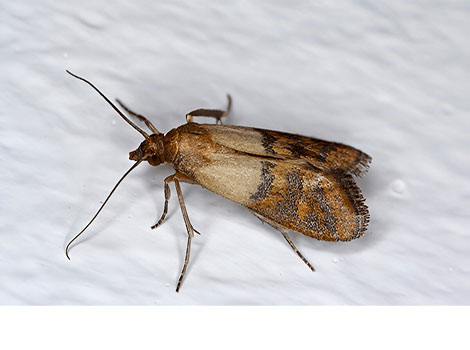
| Attributes | Quick facts |
|---|---|
| Size | Wingspan 0.5–0.8 in (13–20 mm) |
| Weight | Less than 0.01 oz (under 0.3 g) |
| Lifespan | 1–2 months |
| Habitat | Stored food areas and dried fruit storage facilities worldwide |
| Diet | Larvae feed on dried fruits, nuts, and stored grains; adults do not feed |
| Social Structure | Solitary |
| Conservation | Not at Risk |
Fun Fact: When faced with unfavorable environmental circumstances, the larvae of the dried fruit moth enter a state of dormancy.
70. Deathwatch Beetle
Deathwatch Beetle (Xestobium rufovillosum) is a member of the Ptinidae family and is found in regions such as Europe, North America, and Asia. The beetle is brown and has a cylindrical body covered with tiny hairs. The size of this beetle ranges from 5 to 9mm in length. The larvae stage of this beetle can last up to ten years, during which they bore into and feed on timber before emerging as adults.
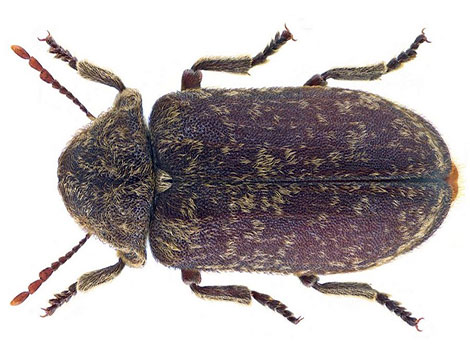
| Attributes | Quick facts |
|---|---|
| Size | 0.2–0.3 inches (5–7 mm) |
| Weight | 0.002–0.004 oz (50–120 mg) |
| Lifespan | 1–10 years (larval stage), a few months (adult) |
| Habitat | Decayed wood in temperate regions |
| Diet | Wood and cellulose materials |
| Social Structure | Solitary |
| Conservation | Not a concern |
Fun Fact: The ticking sound of the Deathwatch Beetle was historically considered an omen of impending tragedy.
71. Desert Locust
Desert locusts (Schistocerca gregaria), a type of grasshopper, inhabit the arid (dry) regions of northern and eastern Africa, Arabia, and southwest Asia. These insects typically measure up to 2–3 inch (5–8 cm) in length and weigh around 0.07–0.1 oz (2–3 g).
They possess powerful legs for jumping and expansive wings for long-distance travel. Interestingly, their coloration varies depending on their social behavior. Solitary locusts exhibit different pigmentation compared to their gregarious counterparts, who form large swarms and exhibit migratory patterns. During these phases, they can fly at speeds of 16 to 19 kilometers per hour (10 to 11.8 miles per hour).
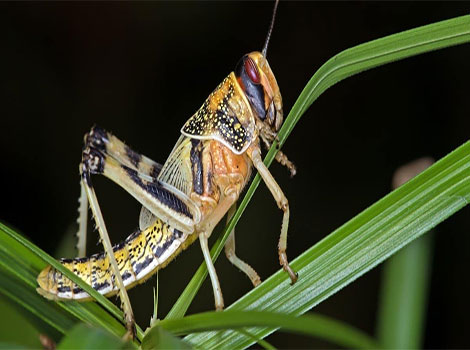
| Attributes | Quick facts |
|---|---|
| Size | 2–3 inch (5–8 cm) |
| Weight | Approximately 0.07–0.1 oz (2–3 g) |
| Lifespan | 3–5 months |
| Habitat | Deserts and arid regions of Africa, the Middle East, and South Asia |
| Diet | Herbivorous; consumes leaves, crops, and grasses |
| Social Structure | Solitary or gregarious; forms massive swarms under favorable conditions |
| Conservation | Not at Risk |
Fun Fact: A desert locust can eat its weight in vegetation every day.
72. Diamondback Moth
Diamondback Moth (Plutella xylostella) is a member of the Plutellidae family and is found globally, particularly in regions where cruciferous crops are grown, such as Europe, Southeast Asia, Australia, and New Zealand. These animals have grayish-brown, often with a cream-colored band forming a diamond along its back. They have a wingspan of about 15 mm and a body length of 0.4–0.6 inches (1–1.5 cm). The females lay their eggs exclusively on plants in the Brassicaceae family. The larvae are known to cause significant damage to the leaves of these plants.
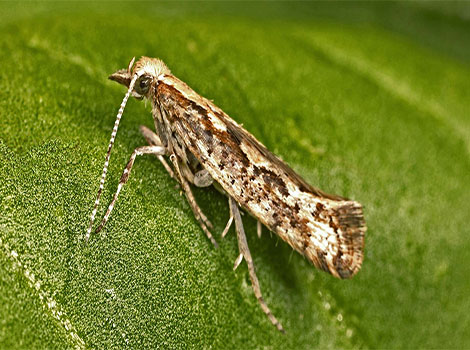
| Attributes | Quick facts |
|---|---|
| Size | 0.4–0.6 inches (1–1.5 cm) |
| Weight | 0.0002 oz (5–6 mg) |
| Lifespan | 1–2 weeks |
| Habitat | Crops, gardens, and open fields worldwide |
| Diet | Cruciferous plants (e.g., cabbage, broccoli) |
| Social Structure | Solitary |
| Conservation | Not a concern |
Fun Fact: Diamondback moths can migrate over vast distances.
74. Dubia Cockroach
Dubia Cockroach (Stomiidae) is a member of the Blaberidae family, originating from the southern regions of South America. They have a dark brown to black coloration, with lighter orange spots or stripes. They display sexual dimorphism, with males possessing full wings and females having only small wing stubs. The average size of this species varies between 1.6 to 1.8 inches in length. As scavengers, they feed on decaying plant matter, fruits, and other organic materials.
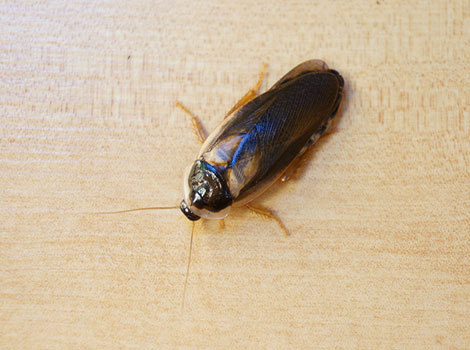
| Attributes | Quick facts |
|---|---|
| Size | 1.5–2 in (4–5 cm) |
| Weight | Approximately 0.1–0.2 oz (3–6 g) |
| Lifespan | 1–2 years |
| Habitat | Tropical and subtropical forests in Central and South America |
| Diet | Omnivorous; consumes fruits, vegetables, and decaying organic matter |
| Social Structure | Lives in colonies |
| Conservation | Not at Risk |
Fun Fact: Despite having wings, male Dubia Cockroaches do not fly, but may flutter to the ground if dropped.
75. Death’s Head Cockroach
Death’s Head Cockroach (Blaberus craniifer) is a species of cockroach native to Mexico, the West Indies, and Central America. This insect is distinguished by its jet-black cloak-like marking on its wings and a skull-shaped, amber/black marking on its pronotum. It can grow to in length and is slightly more than 1 inch wide.
They are nocturnal creatures that prefer to stay near the ground in shady, damp environments. During the day, they often hide away under logs, rocks, and other debris to avoid predators. These insects are typically quite timid around humans and will attempt to run away or hide when disturbed.
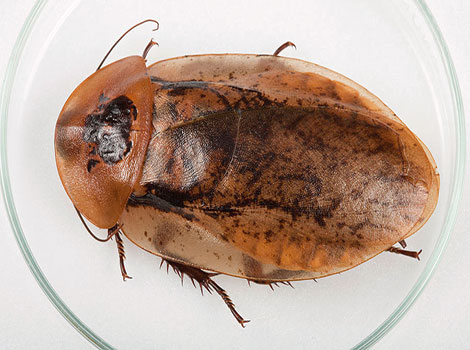
| Attributes | Quick facts |
|---|---|
| Size | 1.5–2 in (4–5 cm) |
| Weight | Approximately 0.1–0.2 oz (3–6 g) |
| Lifespan | 1–2 years |
| Habitat | Tropical and subtropical regions in Central and South America |
| Diet | Omnivorous; consumes decaying organic matter, fruits, and vegetables |
| Social Structure | Lives in colonies |
| Conservation | Not at Risk |
Fun Fact: They can eat half their body weight in one sitting.
76. Darkling Beetle
Darkling Beetle (Tenebrionidae) is a member of the Tenebrionidae family and is found in a variety of habitats, including deserts, forests, and urban areas, with a preference for warm, dry climates. These beetles are black or dark brown and their size varies greatly, ranging to 0.1–1.4 inches (2.5–35 mm). They exhibit activity during both day and night and burrow under sand during the hottest part of the day to stay cool.
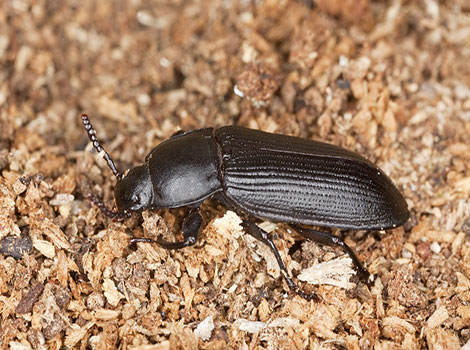
| Attributes | Quick facts |
|---|---|
| Size | 0.1–1.4 inches (2.5–35 mm) |
| Weight | 0.002–0.2 oz (50–5,600 mg) |
| Lifespan | 1–20 years (varies by species) |
| Habitat | Deserts, forests, and agricultural areas worldwide |
| Diet | Decaying plant matter, grains, fungi |
| Social Structure | Solitary or small groups |
| Conservation | Not a concern |
Fun Fact: Darkling Beetles use their segmented antennae to gather information about their surroundings.
77. Dung Beetle
Dung Beetle (Scarabaeidae) is a member of the Scarabaeidae family. These creatures are found in various parts of the world, excluding Antarctica. They are black, brown, or purplish yellow, and some species even have a metallic sheen. Their size can range from 0.2–2.4 inches (5–60 mm). They feed on feces, and some species can bury dung 250 times their mass in one night.
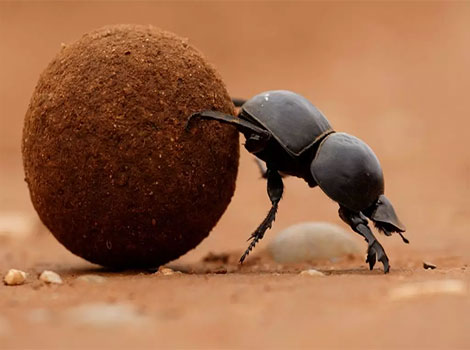
| Attributes | Quick facts |
|---|---|
| Size | 0.2–2.4 inches (5–60 mm) |
| Weight | 0.002–0.35 oz (50–10,000 mg) |
| Lifespan | 3–5 years |
| Habitat | Grasslands, forests, deserts, and farmlands worldwide |
| Diet | Animal feces |
| Social Structure | Solitary or small groups |
| Conservation | Not a concern |
Fun Fact: Dung Beetles are capable of moving dung balls that weigh up to 50 times their weight.
78. Dobsonfly
Dobsonfly (Corydalinae) is a member of the Corydalidae family within the Megalopteran order and is native to the Americas, Asia, and South Africa. They have long cylindrical bodies with short legs, and their color can range from yellow to various shades of brown. Adult Dobsonflies measure between 2 to 2.5 inches in length, with a wingspan of 4 to 5.5 inches. The mandibles of male Dobsonflies can reach up to an inch and a half in length. Dobsonflies are nocturnal creatures that are attracted to light.
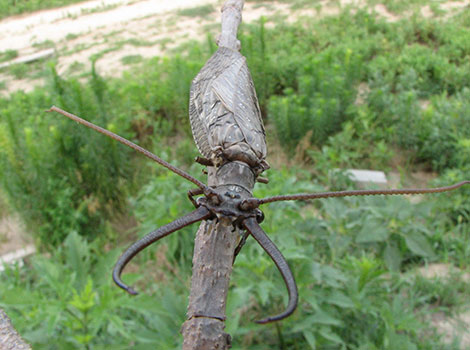
| Attributes | Quick facts |
|---|---|
| Size | 2–5 inches (5–12 cm, including wingspan) |
| Weight | 0.07–0.14 oz (2–4 g) |
| Lifespan | A few days (adult stage) |
| Habitat | Near freshwater streams and rivers |
| Diet | Larvae: aquatic invertebrates; Adults: do not feed |
| Social Structure | Solitary |
| Conservation | Not a concern |
Fun Fact: Despite their fierce appearance, male Dobsonflies are completely harmless to humans and do not bite or sting.
79. Devil’s Coach Horse Beetle
Devil’s Coach Horse Beetle (Ocypus olens) is a species of rove beetle. It is a long-bodied, black beetle, measuring between 0.8–1.2 in (20–30 mm) in length. It has a uniformly black body, short wing cases, and a long, thick abdomen. When threatened, it raises its abdomen in a scorpion-like style and opens its powerful jaws. This beetle is common across the UK and occurs in a variety of habitats including woodland, grassland, gardens, and hedgerows.
It prefers areas that are moist and shaded, such as under rocks or fallen logs. It is a nocturnal insect that is active at night and rests during the day. It is a solitary insect and does not form colonies or nests like some other species. It is a predator, hunting mainly by night, feeding on a range of invertebrates, including worms, slugs, spiders, small moths, and woodlice.
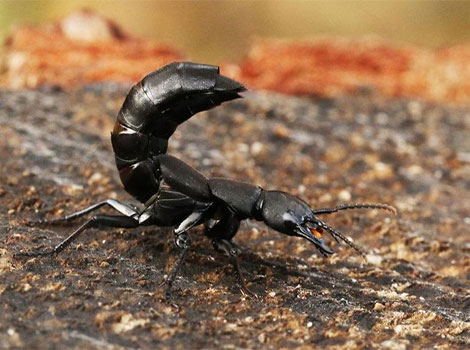
| Attributes | Quick facts |
|---|---|
| Size | 0.8–1.2 in (20–30 mm) |
| Weight | Approximately 0.05–0.1 oz (1.5–3 g) |
| Lifespan | 1–2 years |
| Habitat | Forests, grasslands, and gardens across Europe and North Africa |
| Diet | Carnivorous; feeds on insects, spiders, and small invertebrates |
| Social Structure | Solitary |
| Conservation | Least Concern |
Fun Fact: Devil’s coach horse beetle has the ability to release an unpleasant compound as a means of warding off predators.
Finally, after exploring mammals to insects, we’ll uncover other animals starting with ‘D’ that don’t neatly fit into these categories yet are just as intriguing.
Other Animals that start with D
Animals such as the Deer Tick expand our understanding of life on Earth, representing the incredible diversity and evolutionary history of creatures that start with ‘D.’
| Deer Tick | Disco Clam | Darwin’s Bark Spider |
| Dungeness Crab | Decorator Crab |
80. Deer Tick
Deer Tick (Blacklegged Tick) is a species of tick that is prevalent in various regions of the United States. They prefer forested regions with a wide variety of low bushes and shrubs. They live in shady, moist areas at ground level, clinging to tall grass, brush, and shrubs. They measure 0.08–0.2 in (2–5 mm) in length and less than 0.01 oz (under 0.3 g) in weight.
Additionally, they have a typical tick-like appearance with a rounded body and specialized mouthparts. Their diet consists solely of animal blood, and they consume food only thrice in their lifetime: once during the transition from larva to nymph; once when they mature from nymph to adult; and once more as adults for egg-laying purposes.
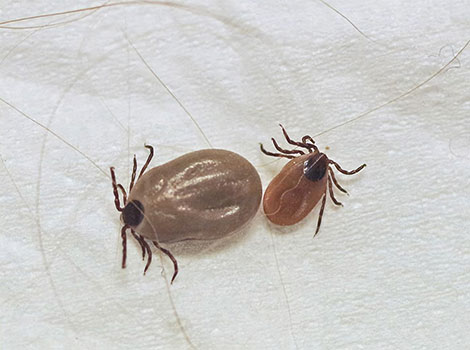
| Attributes | Quick facts |
|---|---|
| Size | 0.08–0.2 in (2–5 mm) depending on life stage |
| Weight | Less than 0.01 oz (under 0.3 g) |
| Lifespan | 2–3 years |
| Habitat | Forests, grasslands, and shrublands in North America |
| Diet | Blood from mammals, birds, reptiles, and amphibians |
| Social Structure | Solitary |
| Conservation | Data Deficient |
Fun Fact: Despite their small size, deer ticks can cause a lot of harm.
81. Disco Clam
Disco Clam (Ctenoides ales) is a member of the Limidae family and is native to the tropical waters of the Indo-Pacific region. It measures about 1.2 to 2 inches (3–5 cm) in size and weighs less than 0.1 ounces (under 3 grams). Beside, it thrives in the crevices and small caves of coral reefs. The clam has a reddish-orange mantle tissue and a tan shell. This mollusk, which measures up to 4 inches, is an active filter-feeder that primarily consumes plankton.
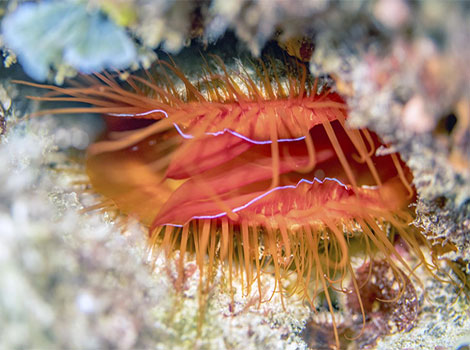
| Attributes | Quick facts |
|---|---|
| Size | 1.2–2 in (3–5 cm) |
| Weight | Less than 0.1 oz (under 3 g) |
| Lifespan | Unknown, estimated several years |
| Habitat | Coral reefs in the Indo-Pacific region, typically at depths of 10–160 ft (3–50 m) |
| Diet | Filter feeder; consumes plankton and organic particles |
| Social Structure | Solitary |
| Conservation | Data Deficient |
Fun Fact: The Disco Clam increases its rate of flashing when predators are around.
82. Darwin’s Bark Spider
Darwin’s bark spider (Caerostris darwini), a majestic orb-weaver spider, holds the title for spinning the largest known orb webs on Earth. These impressive structures can reach diameters of up to 0.7–1 in (18–25 mm), with anchor lines extending an astounding 82 feet (25 meters). Their prominent abdomens are predominantly black in color, adorned with patches of white hair. Perhaps their most remarkable feature is the production of exceptionally strong silk, known to be several times tougher than steel of the same weight.
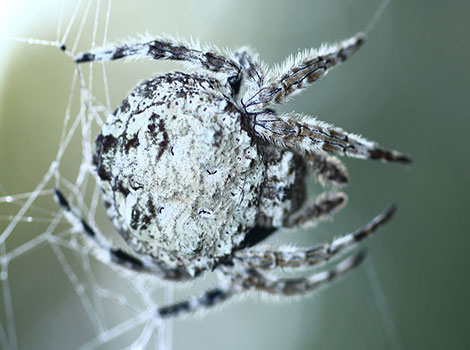
| Attributes | Quick facts |
|---|---|
| Size | Females: 0.7–1 in (18–25 mm); Males: 0.2–0.3 in (6–8 mm) |
| Weight | Females: ~0.1 oz (3 g); Males: ~0.02 oz (0.5 g) |
| Lifespan | 1–2 years (females live longer than males) |
| Habitat | Riverbanks and forests in Madagascar |
| Diet | Insects trapped in their large orb webs |
| Social Structure | Solitary |
| Conservation | Least Concern |
Fun Fact: The silk spun by the Darwin’s Bark spider is 10 times stronger than Kevlar.
83. Dungeness Crab
Dungeness Crab (Cancer magister) is a decapod that inhabits sandy or muddy bottoms of oceans. The color of the crab is beige to light brown with blue trim. The carapace width of a mature Dungeness crab may reach 10 inches (25.4 cm), but typically measures between 6–10 in (15–25 cm). The average weight of these crabs is between 2-3 pounds. They are both scavengers and predators, with a diet that can include shrimp, mussels, small crabs, clams, and worms.
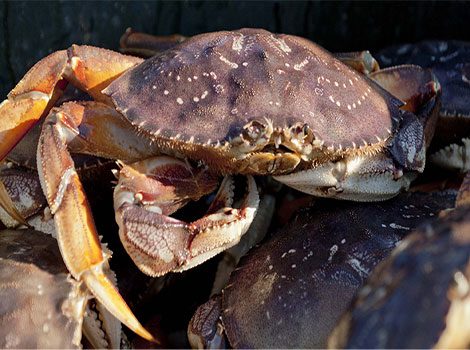
| Attributes | Quick facts |
|---|---|
| Size | 6–10 in (15–25 cm) across the shell |
| Weight | 1.5–4 lbs (0.7–1.8 kg) |
| Lifespan | 8–13 years |
| Habitat | Coastal waters and sandy or muddy bottoms along the Pacific coast of North America |
| Diet | Omnivorous; feeds on fish, mollusks, crustaceans, and plant matter |
| Social Structure | Solitary |
| Conservation | Least Concern |
Fun Fact: Unlike other types of seafood, 99% of the Dungeness crab we buy in the United States is actually from the United States.
84. Decorator Crab
Decorator Crab (Majoidea) is a marine creature that can be found in various habitats, including coral reefs, rocky shores, and seagrass beds. It has a brownish-tan body that is often covered in orange and white sponge. The crab is relatively small, with a typical carapace width of around 1–4 in (2.5–10 cm). It uses materials from its environment to hide from or ward off predators. It attaches plants and non-moving animals to its shell as camouflage.
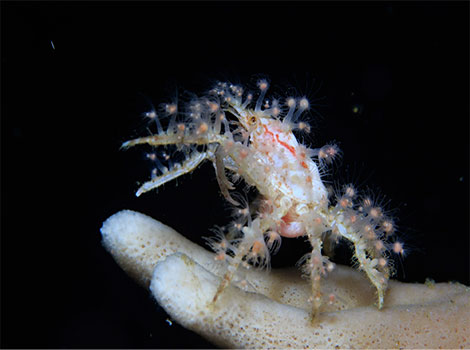
| Attributes | Quick facts |
|---|---|
| Size | 1–4 in (2.5–10 cm), depending on species |
| Weight | Approximately 0.1–1 oz (3–28 g) |
| Lifespan | 1–3 years |
| Habitat | Coastal waters, coral reefs, and rocky seabeds worldwide |
| Diet | Omnivorous; feeds on algae, detritus, and small invertebrates |
| Social Structure | Solitary |
| Conservation | Least Concern |
Fun Fact: When it molts, it carefully removes the decorations from its old shell to reuse on its new one.
FAQs
What wild animal start with D?
Here are the 4 wild animals beginning with the letter D:
- Deathstalker Scorpion is a species native to North Africa and the Middle East. It has a light yellow body with horizontal grayish-brown stripes on the cephalothorax and abdomen. This nocturnal creature usually hides under rocks during the day and hunts at night.
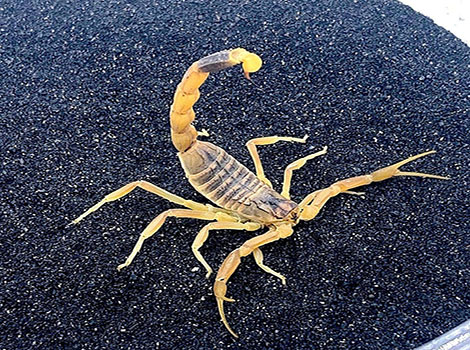
- Dart Poison Frog is native to the rainforests of Central and South America. It has a variety of colors and patterns, with bright colors indicating high toxicity. These frogs are diurnal and often feed on ants and other small insects.
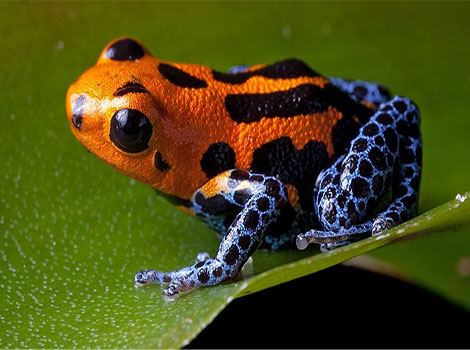
- Dybowski’s Sika Deer inhabited Far Eastern Russia, north-eastern China, and the Korean Peninsula. It has a dark gray fur with reddish areas on the head and lower legs. These deer are solitary animals and are most active at twilight and before sunrise.
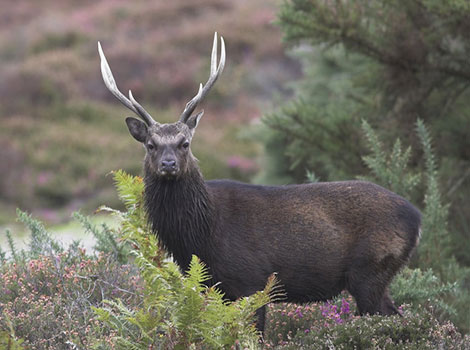
- Desert Kingsnake is native to Texas, Arizona, and New Mexico in the United States. It has a glossy black or very dark brown dorsum, finely speckled with off-white or yellow. These snakes are powerful constrictors and their diet consists of mostly mice if domestic, and other rodents if wild.
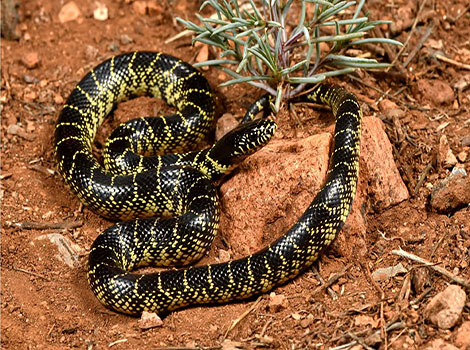
What zoo animals that start with D?
Here are the 3 zoo animals beginning with the letter D:
- Dolphins, found in oceans and rivers worldwide, are known for their intellect and acrobatic abilities. They have a streamlined body, flippers, blowholes, and a layer of blubber for insulation. Dolphins are carnivorous predators.
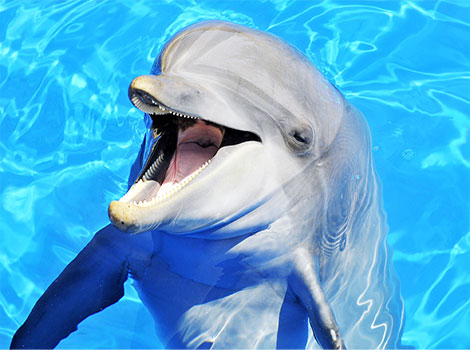
- Deer, adaptable animals, thrive in forested environments. These creatures possess extended, aerodynamic forms, featuring a single dorsal fin on their back, a pair of pectoral fins on their underside, and a tail. Deer are herbivores.
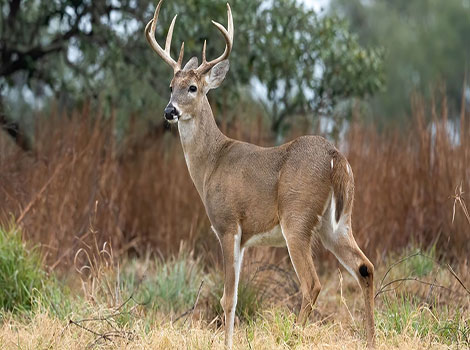
- Dutch Rabbits, small to medium in size, are friendly, playful, and intelligent. They have a well-rounded body, short ears, and glossy fur. They thrive in diverse habitats ranging from grasslands to wetlands.
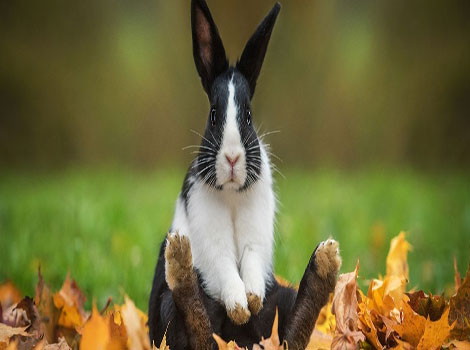
What pet animals that start with D?
Here are the 3 pet animals beginning with the letter D:
- Dachsador, a mix of Dachshund and Labrador, has a long back, short limbs, and a head resembling a Labrador. They are mellow, cheerful, and social, forming close bonds with their family. They are suitable for apartment living.
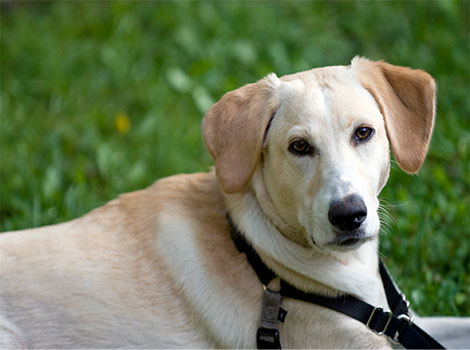
- Dalmatian Mix can have a variety of appearances and behaviors depending on the other breed it’s mixed with. They are generally intelligent, active, and require a yard for exercise
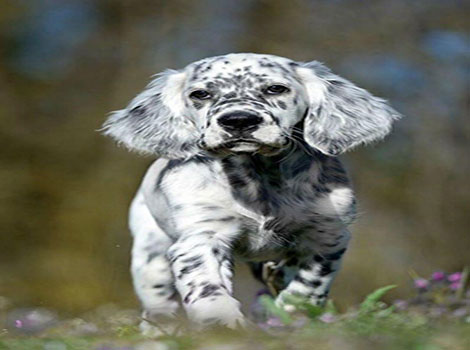
- Dandie Dinmont Terrier, native to England and Scotland, has a long body, short legs, and a distinctive topknot of hair. They are friendly, suitable for interaction with older children, and can thrive in both apartments and larger homes.
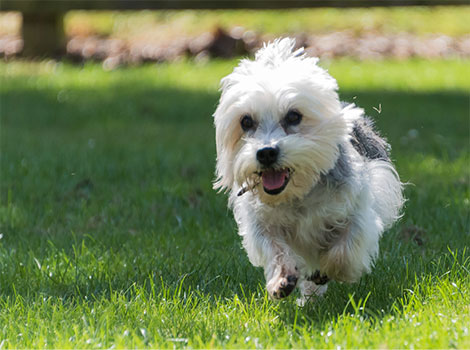
If you’re searching for animal names starting with a different letter, explore our other comprehensive articles dedicated to animal names.
